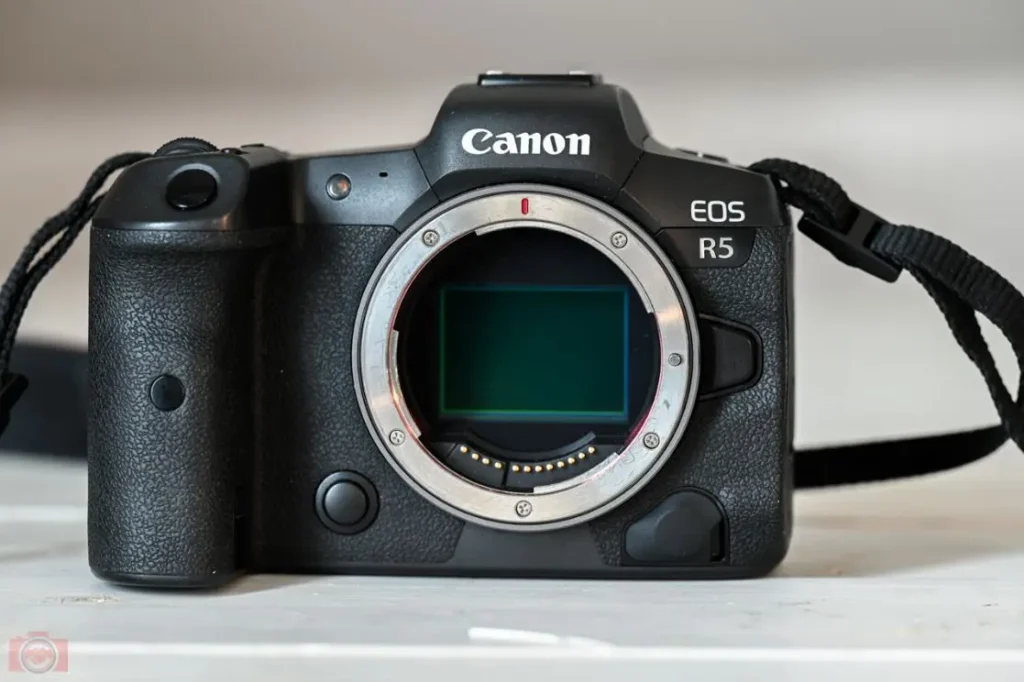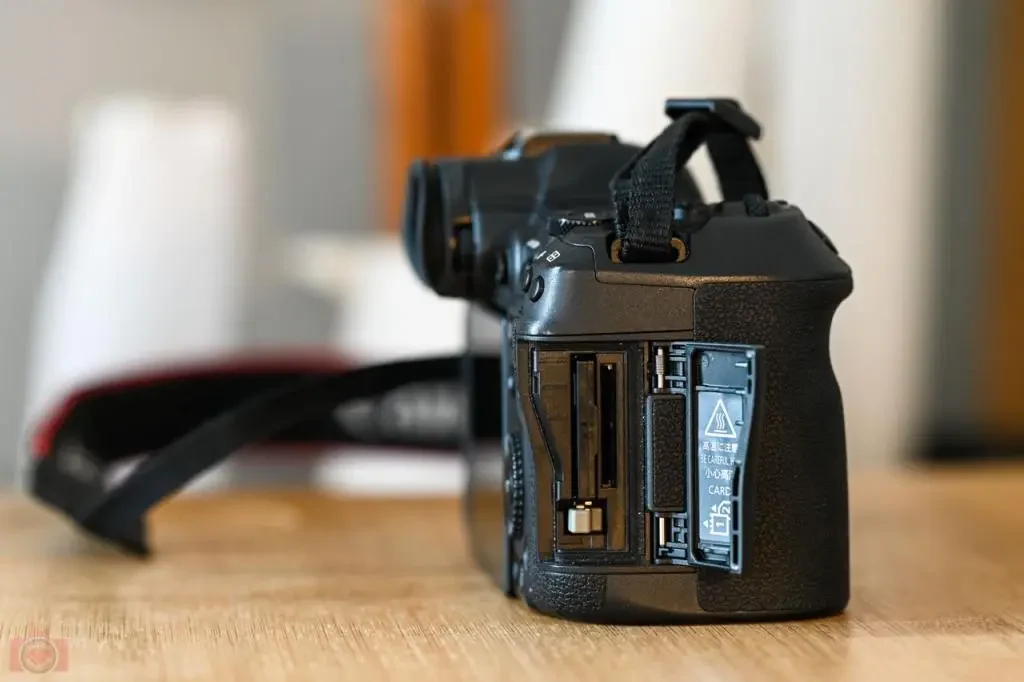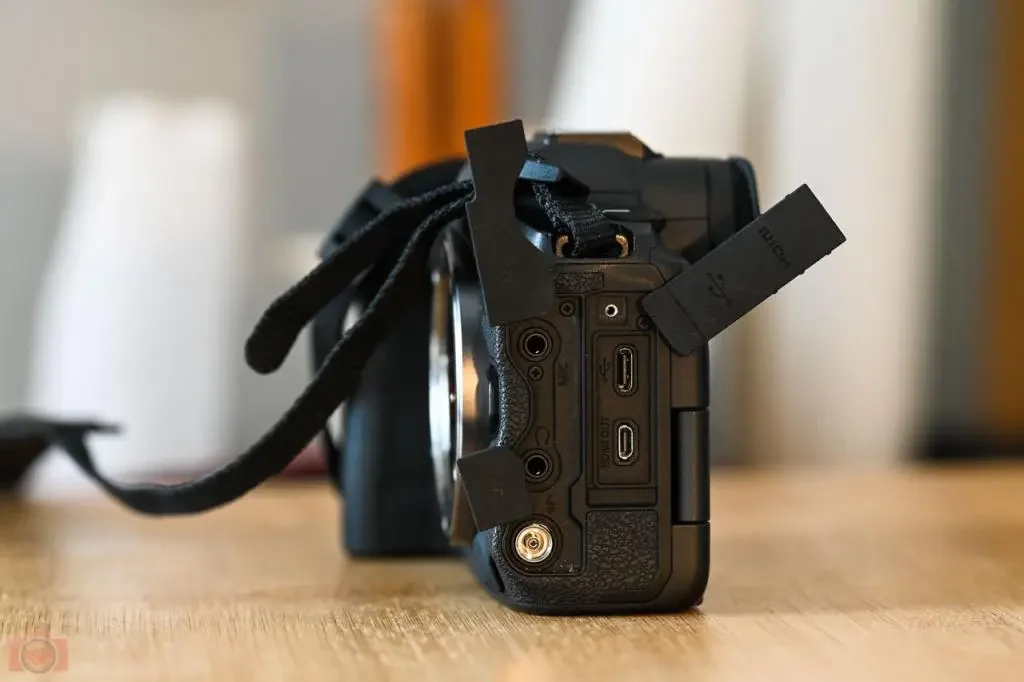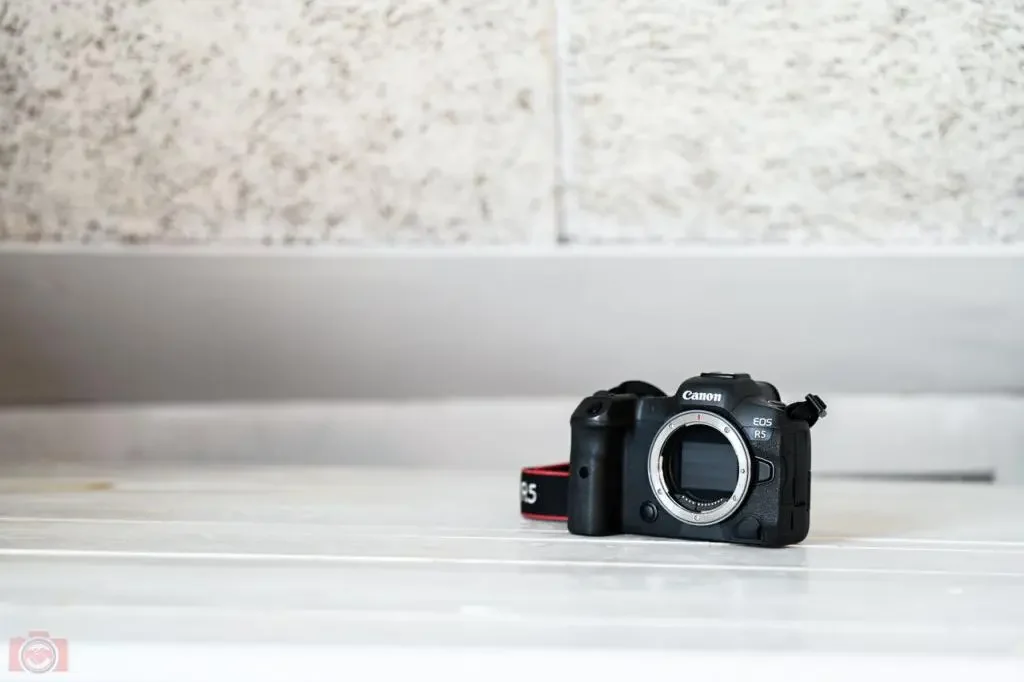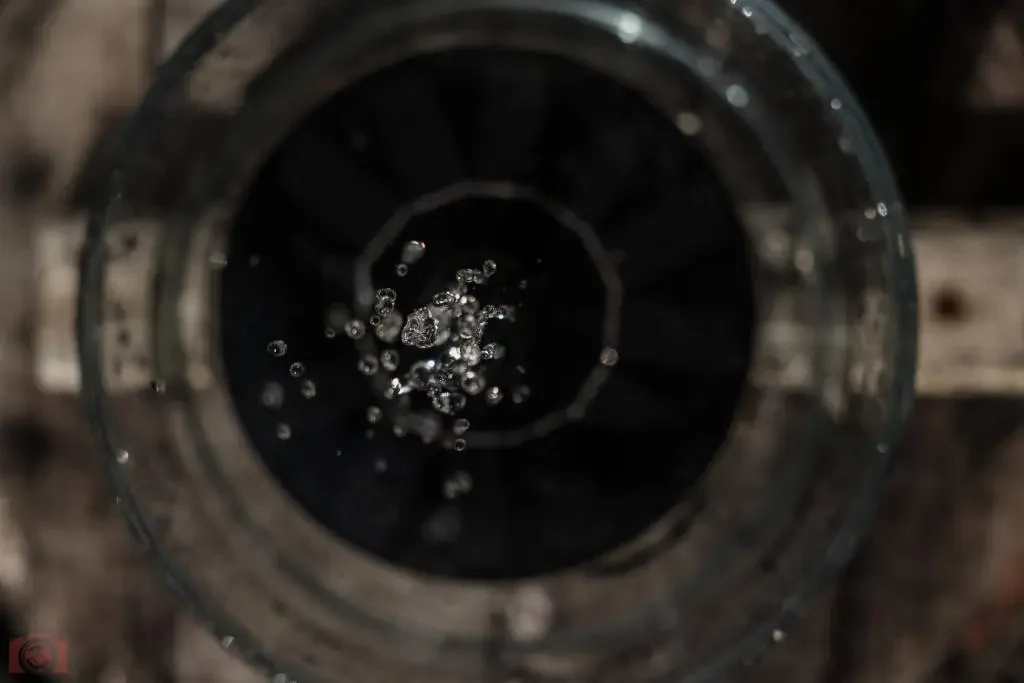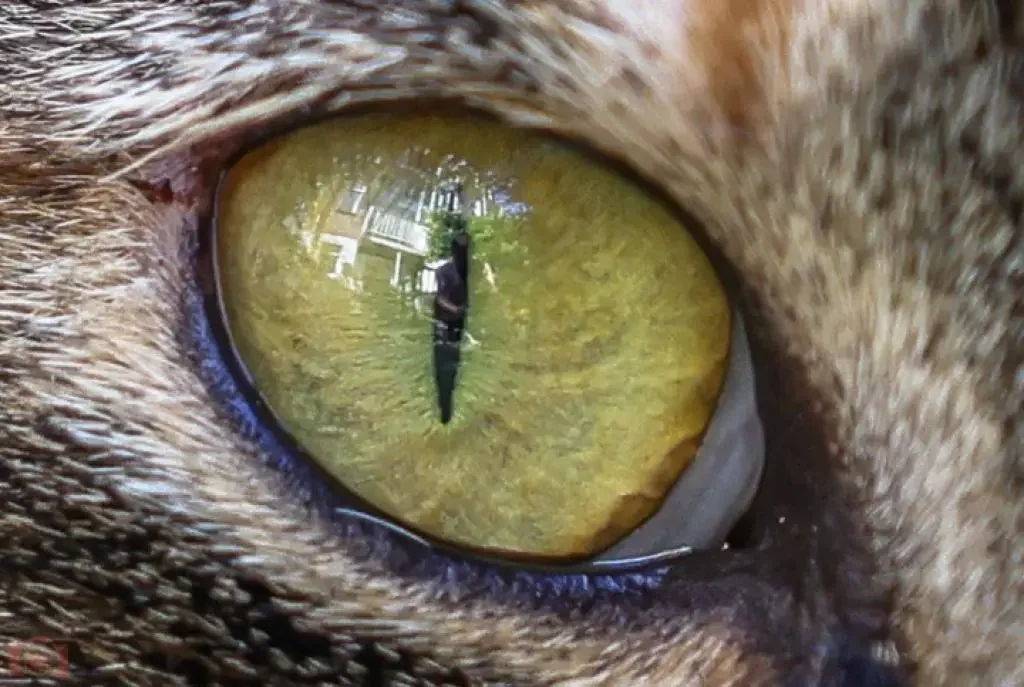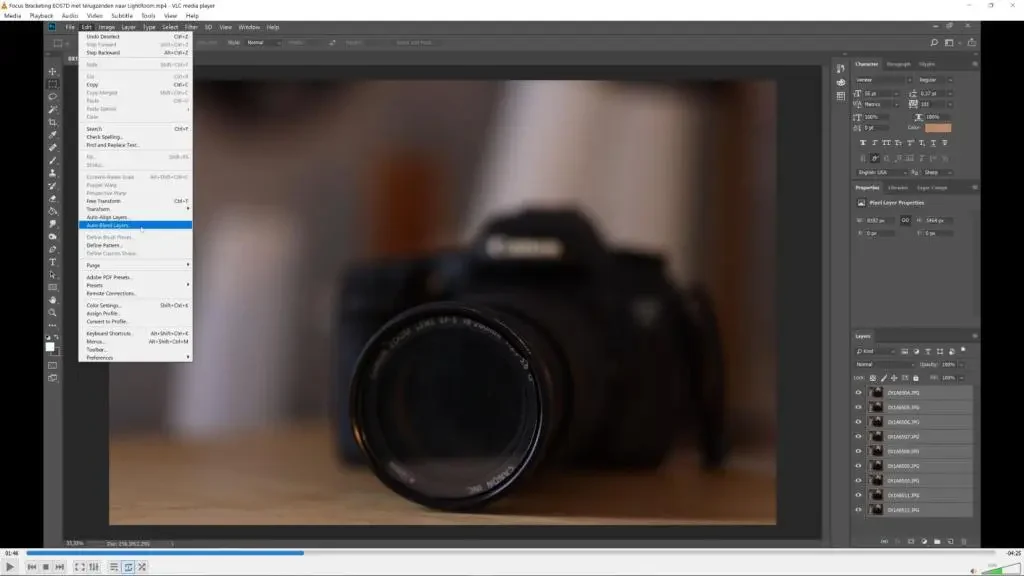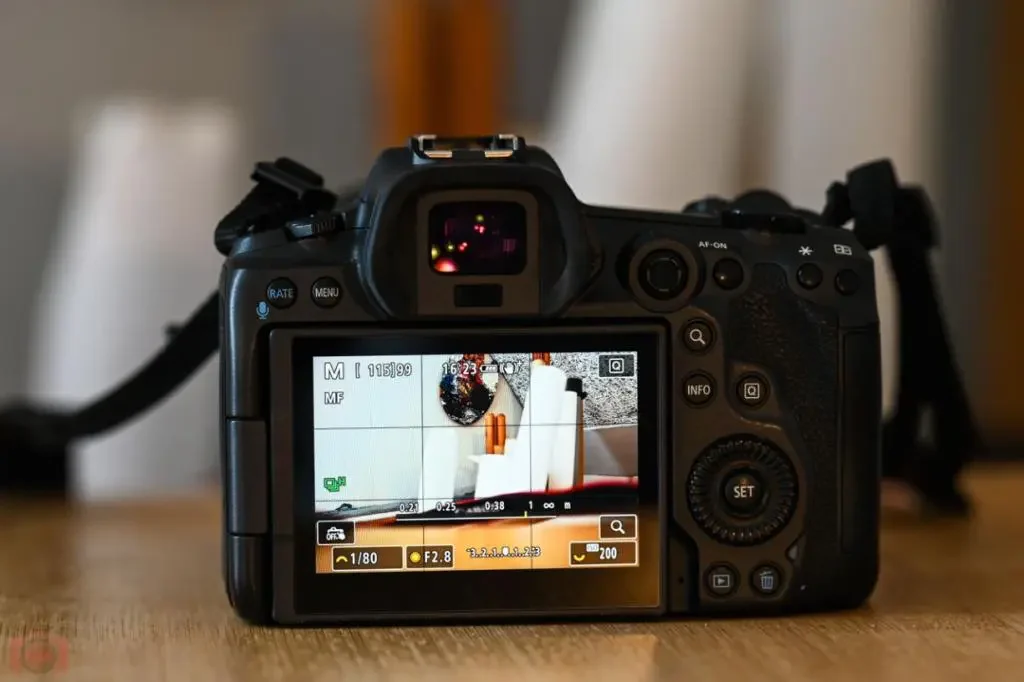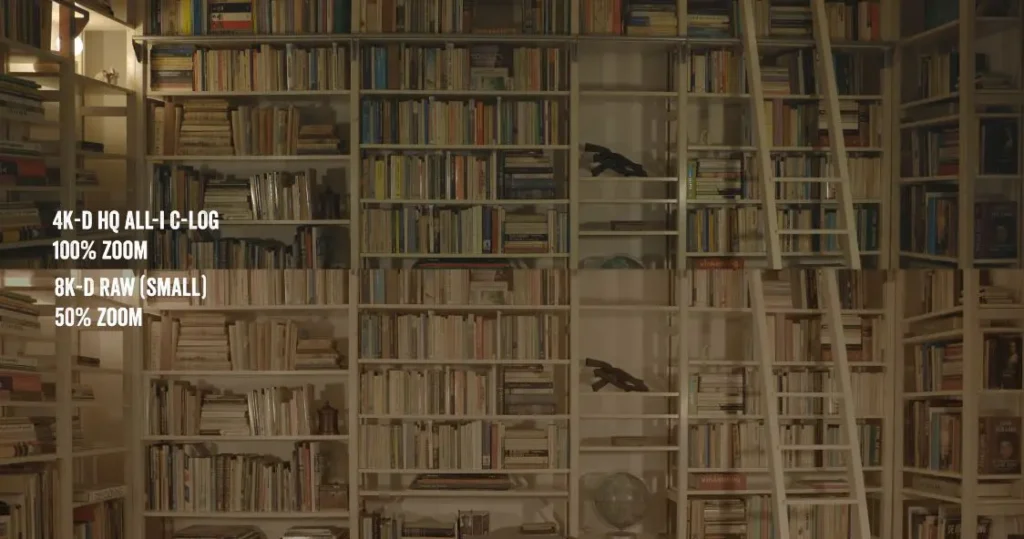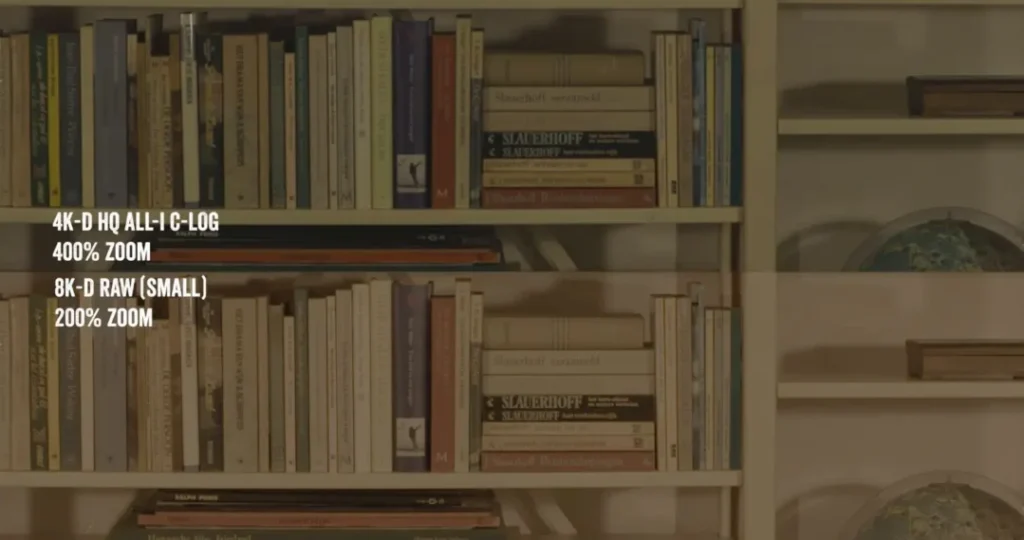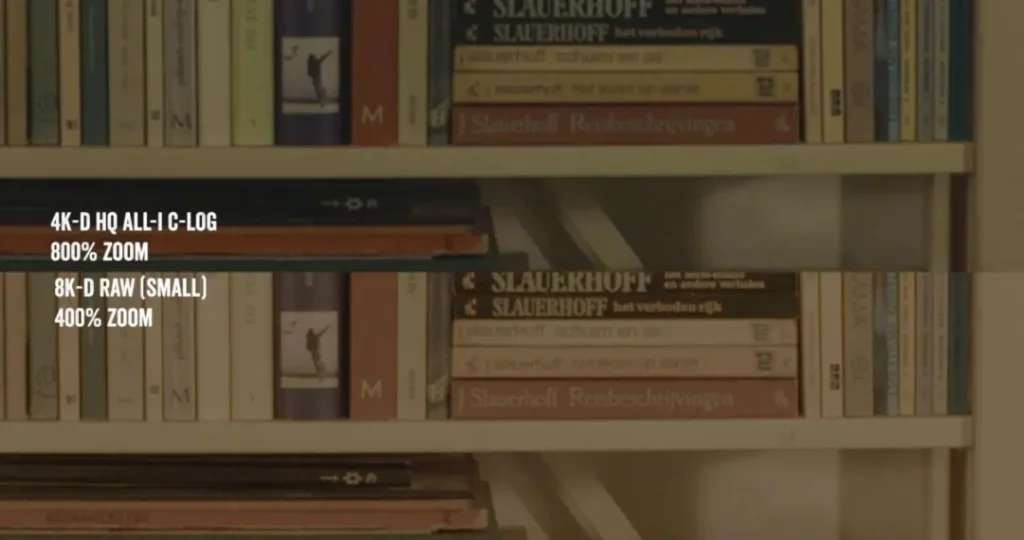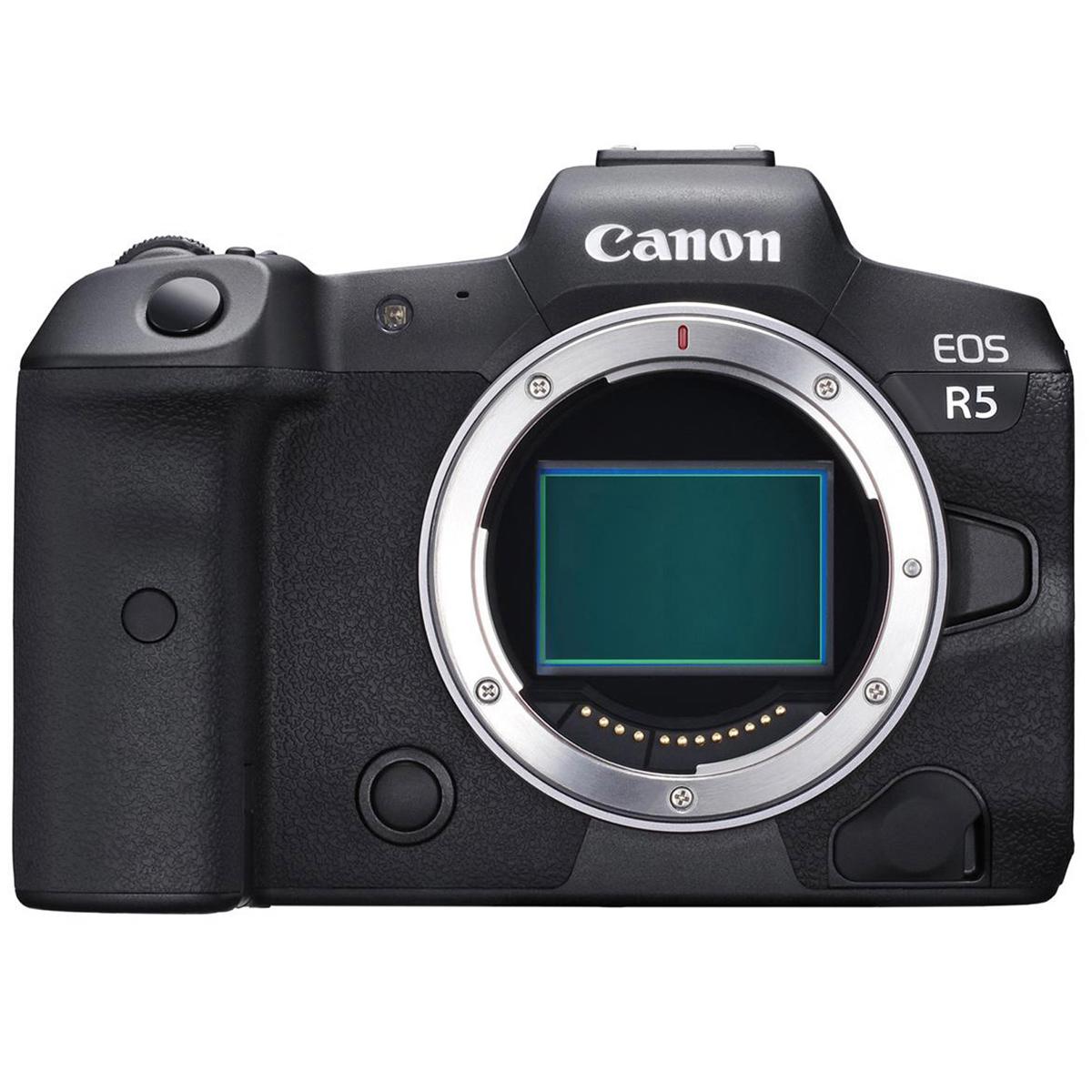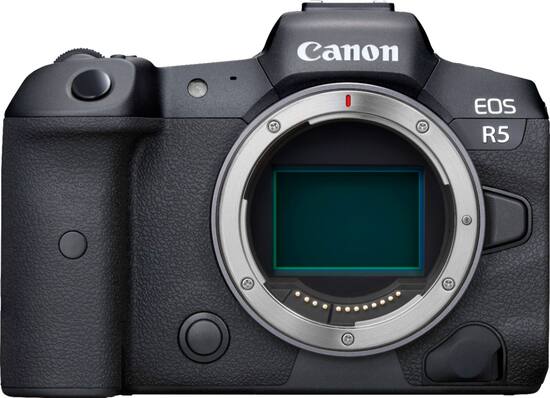Camera Deals Canon EOS R5 test and review: 400MP photography and 8K powerhouse
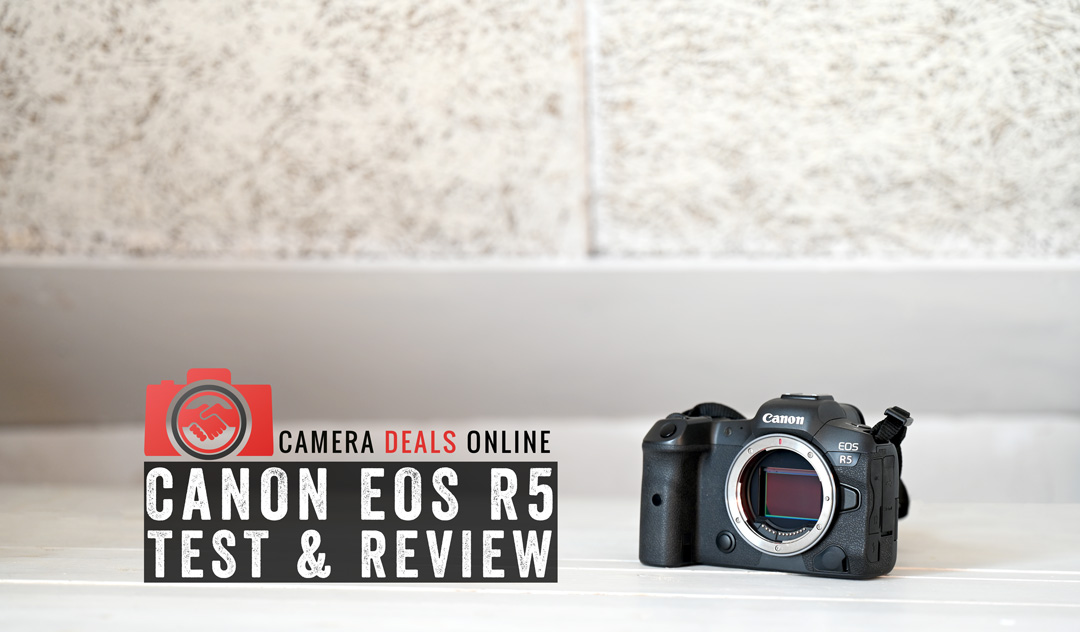
Welcome to the Camera Deals Canon EOS R5 test and review. Canon Netherlands was kind enough to lend me the camera for extensive testing. The Canon EOS R5 was released in 2020 and is one of the most advanced cameras on the market today, featuring an 8K RAW video function and the ability to capture 400-megapixel photos. Of course, I tried out this function as well, but is it really useful? In this review, I’ll share my expert opinion after thoroughly testing the EOS R5.
In this review and test of the Canon EOS R5, I examined the camera in several key areas:
- The body and usability
- Menu navigation
- Button layout
- Quality comparison between 45MP JPEG, RAW, and 400MP photos
- Autofocus for humans, animals, and vehicles
- Autofocus and frames per second (fps)
- Video test of 8K RAW, 4K HQ, 4K 120fps, and Full HD
- Focus bracketing
- Dual Pixel RAW
- ISO and noise test
- Canon RF 24-70mm f/2.8L IS USM Lens
- Canon RF 70-200mm f/2.8L IS USM lens
This review is based on the EOS R5 with V1.8.1 firmware from March 2023, which includes the 400MP update.
Canon EOS R5 Retailers:
This review is 100% independent and not sponsored by Canon (Netherlands) or any other party. Canon (Netherlands) provided the Canon EOS R5 for testing, without any conditions on the final verdict. This article is based on my personal experiences with the camera, and I have formed my opinion and conclusion accordingly.
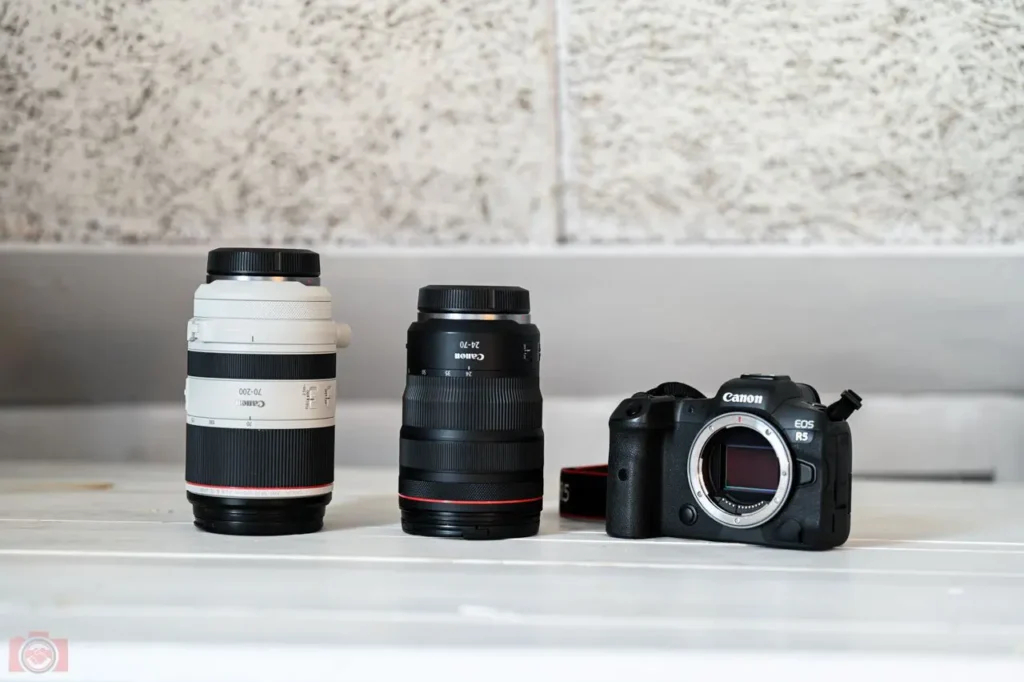
Canon RF 70-200mm f/2.8L IS USM, Canon RF 70-200mm f/2.L IS USM, and Canon EOS R5. Photo: Camera Deals / Yoreh Schipper
Canon EOS R5 Test and Review: General Specifications
The Canon EOS R5 features a full-frame 45-megapixel CMOS sensor, capable of capturing 400-megapixel photos and internally recording 8K RAW and 4K HQ, and 4K 120fps videos. It comes with two card slots, one for CFexpress Type B and the other for an SDHC UHS-II card. This camera is designed for hybrid use, excelling in both photography and videography.
Canon EOS R5 Specifications:
| Canon EOS R5 | Details: |
| Sensor | 45MP Full Frame CMOS |
| Processor | DIGIC X |
| Autofocus | Dual Pixel AF II |
| ISO | 100-51200 (expandable to 50-102400) |
| Resolution Format | 8192 x 5464 45MP | 24576 x 16384 400MP |
| Video | 8K 12-bit RAW | 4K 120fps |
| Viewfinder | 5.76 million dots OLED EVF |
| Memory Cards | 1x SD UHS-II | 1x CFexpress B |
| LCD | 3.2-inch vari-angle touchscreen |
| Burst | 20fps |
| Image Stabilization | 5-axis up to 8 stops |
| Connectivity | Wi-Fi, Bluetooth, NFC, USB-C,
Micro HDMI, Microphone, Headphone |
| Body Size | 138.5 x 97.5 x 88mm |
| Weight | 650 | 738 grams with battery and card |
The camera also features a 5-axis internal image stabilization, stabilizing up to 8 stops when used with a compatible RF lens. Canon integrated the advanced Dual Pixel CMOS AF II focusing system into the camera, capable of recognizing both humans and animals (heads and eyes) and vehicles. The AF system boasts 5940 AF points, covering 100% of the image field.
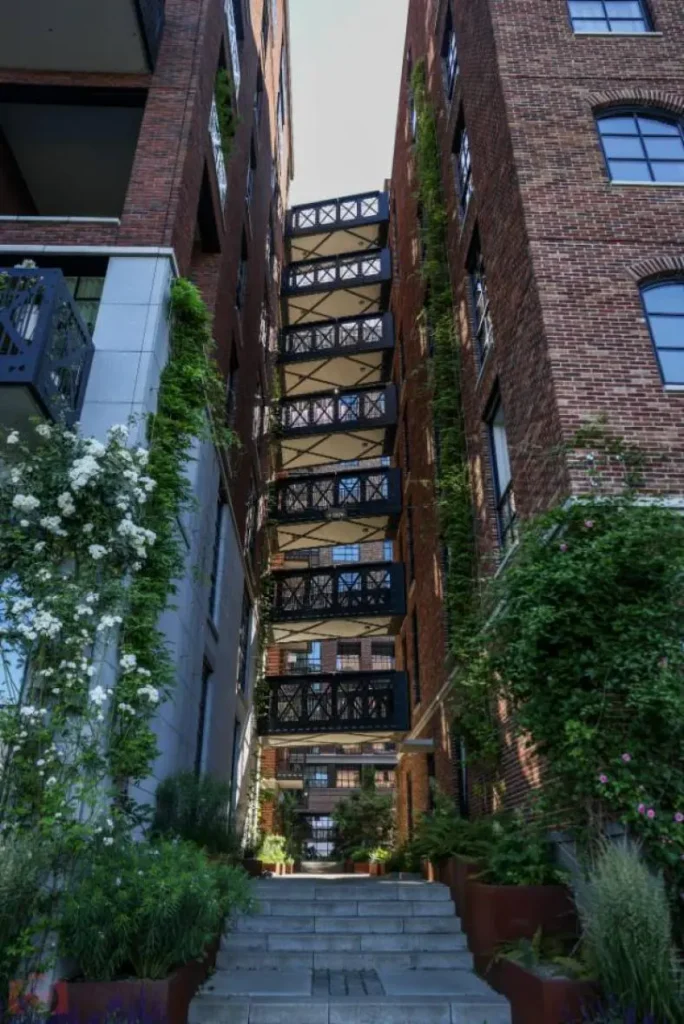
Taken with Canon EOS R5 + RF 70-200mm f/2.8L IS USM at Little C, Rotterdam, The Netherlands. Photo credit: Camera Deals / Yoreh Schipper Photo credit: Camera Deals / Yoreh Schipper. Click for a larger version of higher quality.
Canon EOS R5 Test and Review: Introduction Year
The Canon EOS R5 was launched on July 9, 2020, and became the first mirrorless camera capable of filming in 8K resolution. The camera caught everyone’s attention and became a revolution in the (mirrorless) camera world. No wonder the EOS R5 ranks high on our best mirrorless camera list.
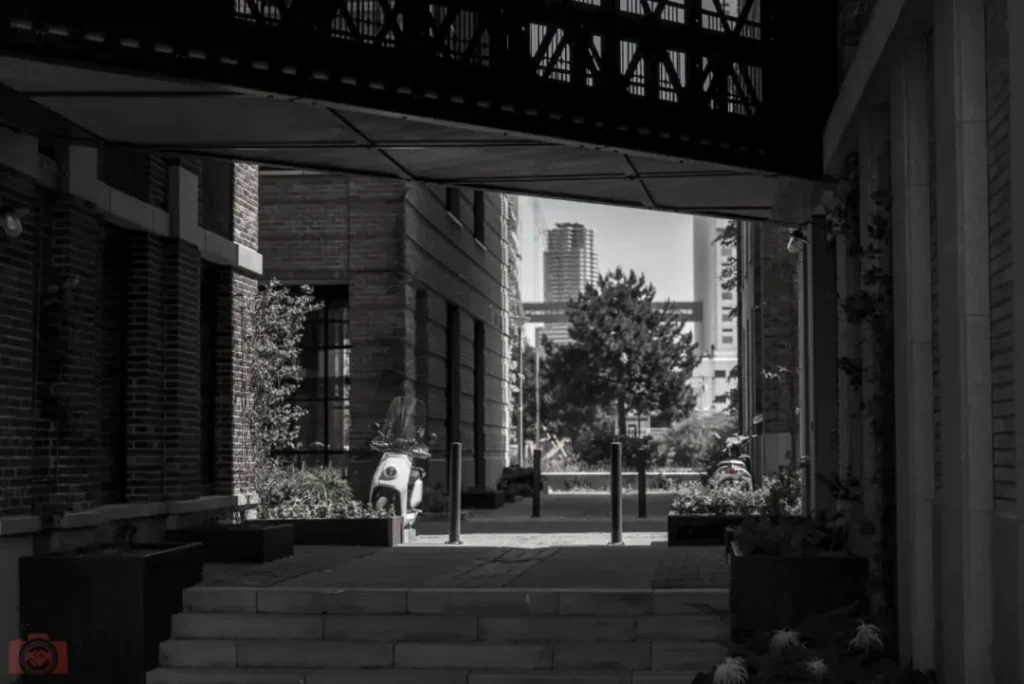
Example photo taken with EOS R5 at Little C, Rotterdam, The Netherlands. Photo credit: Camera Deals / Yoreh Schipper. View this photo in full size.
However, complaints quickly arose. The R5 was prone to overheating at higher bitrates and resolutions. Filming in 8K and 4K became challenging due to constant overheating messages and the camera shutting down. This left frustrated filmmakers waiting for the camera to cool down. Canon’s solution was an external fan that you could attach to the back of the camera, but it came with an extra cost.
Canon EOS R5 Test and Review: Body
Currently, the EOS R5 is Canon’s second-best full-frame mirrorless camera model, just behind the Canon EOS R3. Despite being a professional camera, the first thing you’ll notice is that the EOS R5 is surprisingly light and compact. Without a memory card and battery, it weighs 650 grams (1.43lbs), and with the card and battery, it goes up to 738 grams (1.62lbs). Another noticeable feature is the deep grip, which allows the camera to fit comfortably in your hand. This is essential because RF lenses can be quite heavy, so having a secure grip on the camera is crucial. However, if you have smaller hands, the deep grip might cause some discomfort after prolonged use.
Memory Card Slots
On the left side of the R5, there are two memory card slots, one for CFexpress Type B and the other for SDHC UHS-II cards. While it’s nice that you have the option to use more affordable SD cards, it’s a downside that the card slots don’t support the same type of card. Having dual slots of the same kind is convenient for simultaneous recording or creating a direct backup. Unfortunately, that’s not possible with this configuration. I assume Canon expects professional filmmakers to use an external monitor that records the material externally.
One thing that stands out is Canon’s choice to use a micro HDMI port on the EOS R5, rather than a full-sized HDMI or even a mini HDMI. Despite the unconventional choice, it doesn’t sacrifice speed. You can still output RAW film to devices like the Atomos Ninja V. However, it’s not possible to record the camera’s screen (to a computer) while it’s connected via HDMI and simultaneously record video on the camera. Though this situation might not occur often, it can be useful for creating educational videos.
The decision to go with a micro HDMI port is noteworthy, as it doesn’t feel very stable when a cable is connected, even though there’s enough space for a regular HDMI port.

Photo credit: Camera Deals / Yoreh Schipper
Shutter Options
The Canon EOS R5 offers three shutter options:
- Mechanical
- Electronic
- First Curtain shutter
1. Mechanical: With the mechanical shutter, you can capture an impressive 20 frames per second in the 45MP RAW+JPEG L format, which is undoubtedly impressive for fast-paced photography. This is particularly useful for capturing fast-moving subjects.

Small fountain in the garden. Canon EOS R5, 1/4000s, ISO 250, f/5, 70mm on 24-70mm f/2.8L IS USM. Photo credit: Camera Deals / Yoreh Schipper. View this photo in full size.
2. Electronic: The electronic shutter doesn’t use physical shutter curtains at all. This can be advantageous in situations where complete silence is required, such as when shooting in a quiet environment or photographing animals where the sound of the mechanical shutter could disturb them.
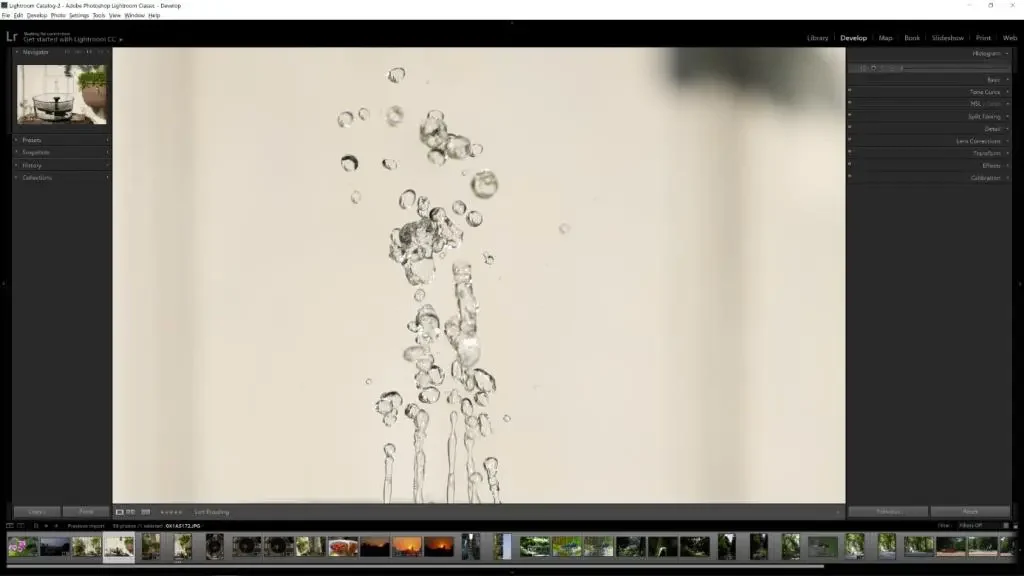
Zoom-in on drops in Lightroom. Photo: Yoreh Schipper / Camera Deals Online
3. First Curtain: This shutter option uses only the first of the two shutter curtains and is partly electronic. First Curtain combines the advantages of both mechanical and electronic shutters, offering fast shooting with reduced vibrations. It is generally considered the best choice in most situations.
Being able to shoot at 20 frames per second and active autofocus and tracking makes it easier and easier to take the perfect picture. But even without autofocus, the 20fps is a handy feature. For example, when capturing a water drop, as in the sample photos.
Battery
The professional EOS R line uses the new version of the LP-E6 battery, the LP-E6NH. This new version, with a capacity of 2130mAh, can be identified by the sparkling sticker on the front. Canon claims that this new version utilizes energy more efficiently, resulting in longer battery life.
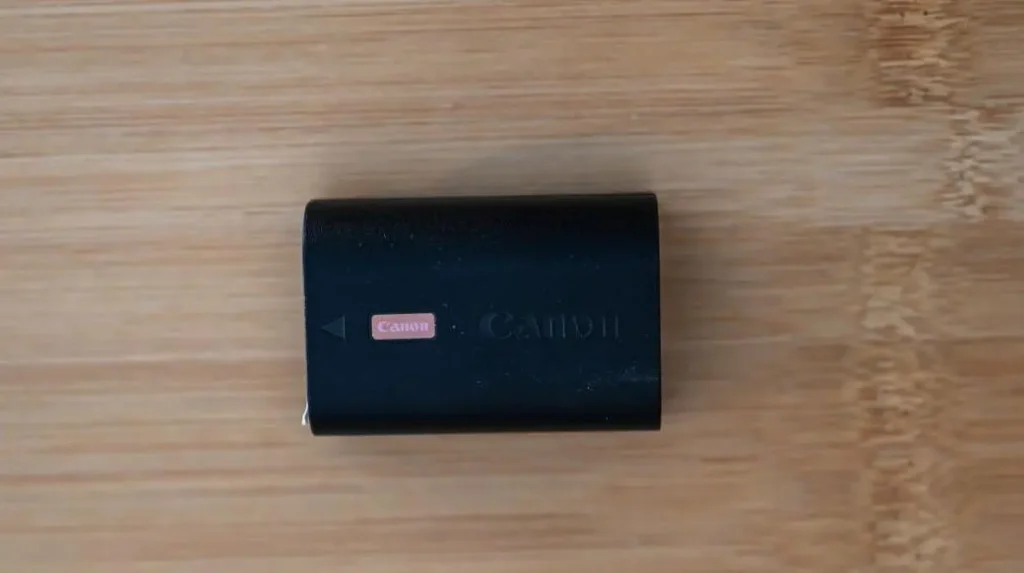
Canon LP-E6NH battery. Photo credit: Camera Deals / Yoreh Schipper
Canon states that a fully charged battery can last for 320 shots.
Canon EOS R5 Test and Review: Photography
The EOS R5 is undoubtedly a versatile camera suitable for various types of photography. Thanks to its full-frame sensor with 45 megapixels, the camera is well-suited for landscape, architecture, portrait, and street photography. Of course, you can also use the camera for sports and wildlife photography, but you’ll need lenses with a larger zoom range. The camera is fast, and it’s capable of shooting up to 20 frames per second with the mechanical shutter, making it ideal for action photography.
For this kind of photography, APS-C sensors can also be handy because they provide a 1.5x or 1.6x crop factor, effectively increasing the focal length of lenses. However, it’s worth noting that full-frame sensors typically perform better in low-light conditions, capturing more light.

Photo credit: Yoreh Schipper / Camera Deals Online
Thanks to the 45 megapixels, reframing images has become much easier, and you can zoom in on details with impressive clarity.
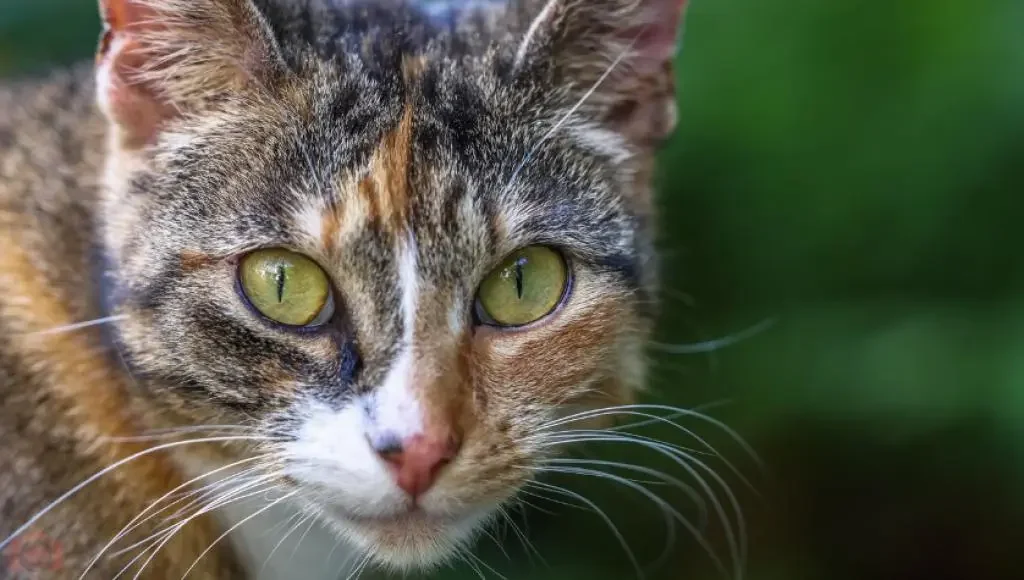
Photo credit: Yoreh Schipper / Camera Deals Online. See this image in full size.
When shooting with the standard color profile, the colors in the photos appear natural and may require minimal editing, given the right settings.
HEIF Photos
To create HEIF (HEIC) photos on the EOS R5, you need to enable the HDR-PQ function in the menu (tab 2 in the photo menu). HEIF or HEIC photos are 10-bit images that have smaller file sizes compared to JPEGs while maintaining higher quality. The downside is that not every platform can directly read these photos. Apple computers can display HEIF photos without plug-ins, but Windows computers require an additional plug-in. However, it is also possible to convert HEIF photos in the EOS R5 to JPEG format. By doing this, you can capture images with a higher bit-depth while storing them as JPEG files.
Dual Pixel RAW
The Dual Pixel RAW function is specific and mainly intended for precise photography. It allows you to adjust the blurriness or sharpness of an image after it’s been taken. This feature is not about focus stacking, but rather making adjustments to the details. It is particularly useful in portrait photography and shooting under bright light conditions. For portraits, you can selectively brighten areas on the face that might have shadows, for example, when a person is wearing a cap casting a shadow on their face. These shadows can be individually brightened even before using highlight and shadow adjustment tools.
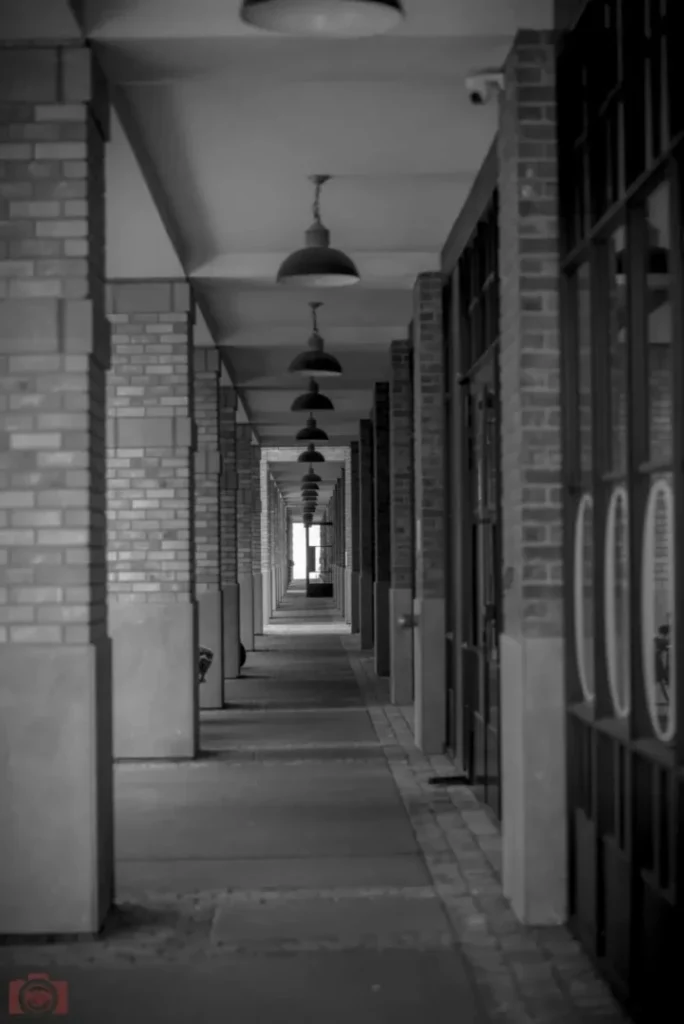
Canon EOS R5 at ‘Little C’, Rotterdam, Netherlands | 1/160s, ISO 100, f/2.8, 79mm | RF 70-200mm f/2.8L IS USM | Photo credit: Camera Deals / Yoreh Schipper. View this photo in full size.
If you take a photo of a tree against the sun, chromatic aberration may occur. Although the RF 24-70 f.2.8L IS USM and 70-200mm f/2.8L IS USM are excellent lenses and prevent chromatic aberration, it can still occur. Dual Pixel RAW helps to reduce this effect. To reduce this, you need to use Canon’s free Digital Photo Professional program. This program is similar to Camera RAW or Adobe Lightroom and lets you use these specific options if you’ve taken photos in Dual Pixel RAW.
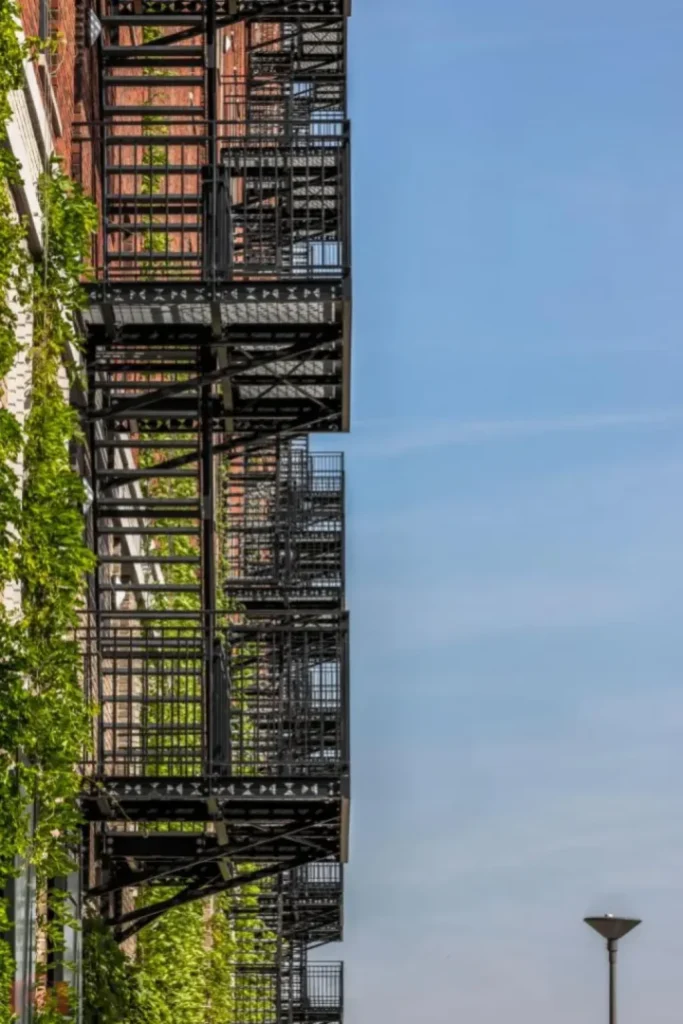
Canon EOS R5 at ‘Little C’, Rotterdam, Netherlands. Stairs with depth | f/29, ISO 400, 1/100s 182mm | RF 70-200mm f/2.8L I USM | Photo credit: Camera Deals / Yoreh Schipper. View this photo in full size.
Focus bracketing on the EOS R5
The focus bracketing function allows the camera to capture up to 999 photos with different focus distances. You can set the steps from 1 to 10, and there is an option for exposure equalization. This feature is ideal for product photographers who want the entire product to be in focus without using a small aperture.

The final result when several photos are stacked on top of each other. Consisting of 9 photos, each with a slightly different focus. Photo: Camera Deals / Yoreh Schipper | Canon EOS R5, 1/50s, f/3.2, ISO 160, 187mm on RF 70-200mm f/2.8L IS USM.
Normally, when photographing a deeper product with a wide aperture, only a small part of the product is in focus. Even at a small aperture like f/32, it is challenging to achieve full focus on a product close to the lens. Moreover, using a small aperture doesn’t produce a pleasingly blurred background. By using the Focus Bracketing function, you can shoot at wider apertures like f/2.8 or f/1.2, resulting in a beautifully blurred background with a sharply focused product in the foreground.

Photo: Camera Deals / Yoreh Schipper
Where cameras like the Panasonic GH6 combine the focus bracketing in the camera for you, with the R series, and therefore also the EOS R5, you have to do this in Photoshop. This is obviously more work, but as a professional photographer, it makes sense that you want to have full control over the focus bracketing. In Photoshop, it is possible to manually adjust the focus areas in the Masks.
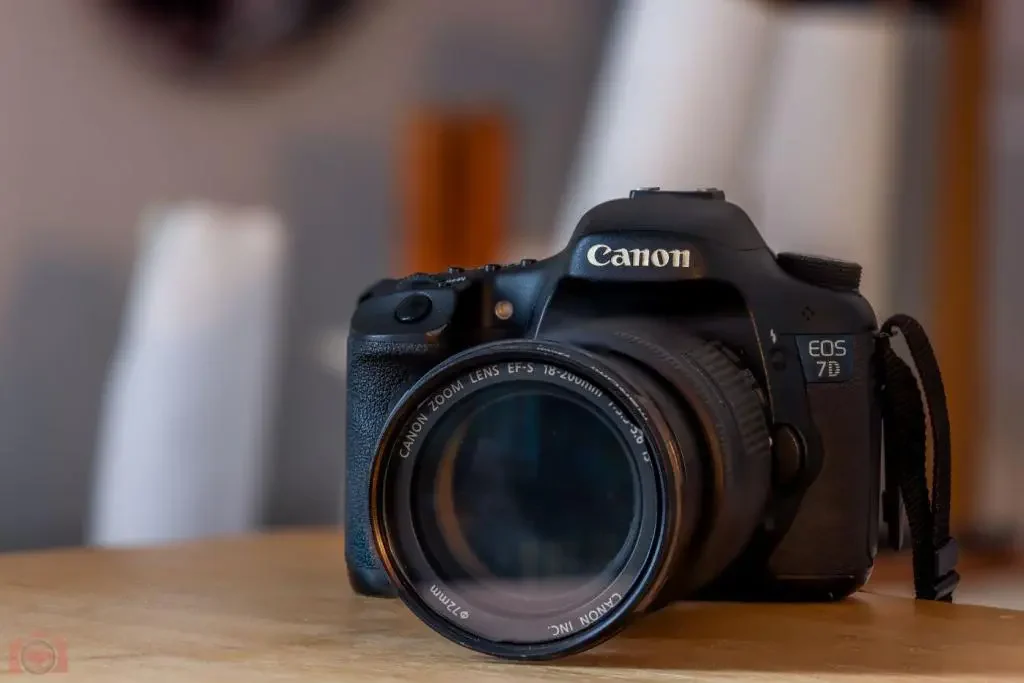
The final result when several photos are stacked on top of each other. Consisting of 9 photos, each with a slightly different focus. Photo: Camera Deals / Yoreh Schipper | Canon EOS R5, 1/50s, f/2.8, ISO 160, 153mm on RF 70-200mm f/2.8L IS USM.
It’s important to note that focus bracketing works best when using a tripod and capturing static subjects. The autofocus needs to be enabled for this feature to work, as the lens needs to change focus points between shots. It’s also recommended to use a two-second timer to avoid any movement or vibration in the first shot.
How to merge focus bracketing photos into one image in Photoshop
The simplest way to merge focus bracketing images into one photo is by using Photoshop. Open all the photos in a project in Photoshop; you can also do this from Lightroom if you’ve edited the photos in that program.
In Lightroom: Select all photos –> Right-click –> Edit in –> Open as layers in Photoshop. This will bring all the photos as layers into one file in Photoshop.
In Photoshop: Select all layers –> Edit –> Auto Blend Layers.
Now you can save the file as a TIF file and reopen it in Lightroom without any loss of quality or compression.
Camera Deals Test and Review: Taking 400MP Photos
Canon surprised everyone by releasing a significant firmware update for the EOS R5, enabling it to capture 400-megapixel images, a feature not found in other cameras. Naturally, I extensively tested this function for the Canon EOS R5 review.
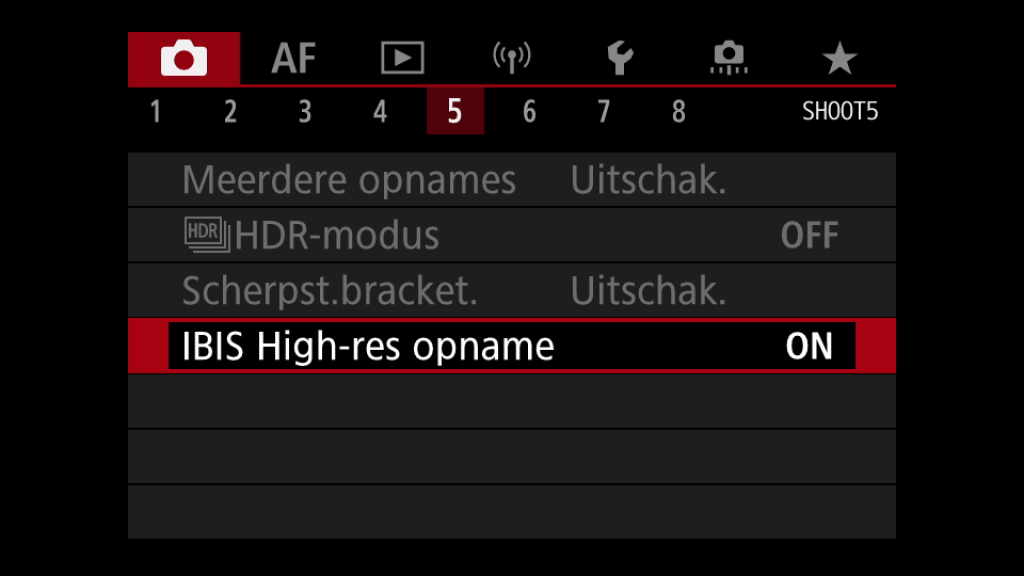
To use the 400MP function on the EOS R5, you need to enable the ‘IBIS High-res’ (IBIS High-res shooting) option in the menu. The men you see is in Dutch, sorry for that.
Pixel Shift is the technique used to capture these massive 400-megapixel images. The camera takes a total of 9 photos, shifting the sensor with each shot. These 9 images are then combined in-camera and exported as a JPEG file. External software is not necessary, which is a relief since the resulting files are enormous. A 400-megapixel photo requires about 115MB to 130MB of storage.
![]()
Here is a comparison of the different file formats for the 400MP photos
Now, let’s delve into the major differences and similarities.
| Canon EOS R5 | 400MP | CR3 RAW | JPEG L |
|---|---|---|---|
| Pixel | 24576 x 16384 | 8192 x 5464 (45MP) | 8192 x 5464 (45MP) |
| MB per photo | 115-130mb | 17-23mb | 9-12mb |
| Format | JPG | CR3 | JPG |
Now, let’s delve into the major differences and similarities.
400MP photos camera set-up:
Capturing 400-megapixel photos cannot be done handheld; a sturdy tripod is essential. It is advisable to use a timer or a remote control to prevent any vibrations. As demonstrated in the example photo, the 400-megapixel image of buildings may not turn out as expected due to even the slightest breeze causing vibrations. Despite minimal wind, enough atmospheric disturbance resulted in an unsharp image. In this case, the RAW photo appears much sharper when zoomed in.
Even with a sturdy tripod and image stabilization, the slightest gust of wind is too much for capturing sharp 400MP photos (see blurry result below). Therefore, always ensure a completely static and controlled setting, especially when using a zoom lens. Photo: Camera Deals / Yoreh Schipper.
Examples of Canon EOS R5 400 Megapixel Photos
Example 1: Building
The first photo is taken at 200mm with the 70-200mm f/2.8L IS USM lens. It is clear that when zooming in on the top photo, the 400MP image, it appears blurry.
Row 1: 400MP, Row 2: RAW CR3, Row 3: 45MP JPEG L. Canon EOS R5 with 70-200mm f/2.8L IS USM at 200mm. It can be seen that the 400 megapixel photo is blurry due to the slight wind that day. Photo: Camera Deals / Yoreh Schipper. View this photo in high resolution.
Example 2: Bookshelf Close-up
Full 400MP compressed photo of the bookshelf. See below this photo for enlargements. Download the 400MP file. Photo: Yoreh Schipper / Camera Deals
On the Slauerhoff book, it is clear that the 400MP photo contains much softer edges around the texts. The middle RAW photo shows quite a bit of noise, while the 45MP photo still holds up well.
Row 1: 400MP, Row 2: CR3 RAW, Row 3: 45MP JPEG L. In this enlargement, it can be seen that the top photo, the 400MP one, is significantly sharper than the other two. Photo: Camera Deals / Yoreh Schipper. View this photo in high resolution.
When we zoom in to 493% on the 400MP image (1450% on JPEG and RAW), we can really see what 400 megapixels can achieve. It is evident that the 400MP photo excels in terms of details.
Row 1: 400MP, Row 2: CR3 RAW, Row 3: 45MP JPEG L. When zooming in further, we can see the individual pixel squares of Photoshop in the bottom two photos, while the top 400MP photo still displays soft and quite sharp lines. Photo: Camera Deals / Yoreh Schipper. View this photo in high resolution.
Example 3: Wide Bookshelf
Full 400MP photo of the bookshelf. Photo: Yoreh Schipper/ Camera Deals. Download 400MP Photo.
Below is the 400MP photo at 100% and the RAW and JPEG photos at 313% to get the same crop.
Row 1: 400MP at 100%, Row 2: CR3 RAW at 313%, Row 3: 45MP JPEG L at 313%. Photo: Camera Deals / Yoreh Schipper. View this photo in high resolution.
Notably, in the photo below is the noise that appears in the CR3 RAW image (middle image). JPEG photos have automatic noise reduction applied, and in RAW images, you have to add this yourself. However, it appears that the internal noise reduction is already doing a good enough job. Of course, noise in RAW photos is normal and easily eliminated when adjusting the black tones. In most basic editing, you may not even need digital noise reduction.
Row 1: 400MP at 100%, Row 2: CR3 RAW at 313%, Row 3: 45MP JPEG L at 313%. In the RAW photo, there is already a lot of visible noise, while in the 400MP photo (top), we can see sharp book edges and texts. The edges of texts in the bottom two photos are harder to read and less sharp. Photo: Camera Deals / Yoreh Schipper. View this photo in high resolution.
Example 4: Painter’s Palette
A painter’s palette can be a work of art in itself and is suitable for comparing colors and contrasts.
Photo of the painter’s palette. Photo: Camera Deals / Yoreh Schipper. Download original 400MP file: Painter’s Palette & Download original 400MP file: Painter’s Palette with zoom.
Row 1: 400MP at 31%, Row 2: CR3 RAW at 100%, Row 3: 45MP JPEG L at 100%. Photo: Camera Deals / Yoreh Schipper. View this photo in high resolution.
Especially in this last comparison between the paint of the three capture modes, we can see the power of 400MP. While the 45MP JPEG and RAW photos fall apart completely in terms of details, we can still see soft color transitions and many details in the 400MP photo (top).
Row 1: 400MP at 100%, Row 2: CR3 RAW at 379%, Row 3: 45MP JPEG L at 379%. Photo: Camera Deals / Yoreh Schipper. View this photo in high resolution.
400 Megapixel Photo Conclusion
The remarkable thing about this feature is that the images are stored as JPEGs with compression. For true pure megapixel information, a RAW photo would be much better. There is indeed a difference between 400 megapixel JPEGs and 24-megapixel photos, which you will only see when you zoom in significantly. A 400MP JPEG photo has a size of about 115MB, and a RAW 400MP photo would likely be four times as large. I hope that 400-megapixel RAW photos become possible so that we can get everything out of the camera. However, this would mean a heavy process, as 9 RAW photos probably cannot be merged in the camera and would have to be done manually on a computer.
That does not have to be a problem since 400MP has specific goals. Think of making huge prints. It is certainly not a feature you use just for fun because it simply takes too much processing time and space. Additionally, the subject must be completely static, and the camera cannot move even a millimeter. The use of zoom lenses is possible, but only if they do not move either. Although the camera has image stabilization, it will not help much in capturing vibrations. Any movement will be visible in the final result.
Is the 400-megapixel feature good and usable?
Yes, but only for specific purposes. In practice, the processing time will be too long, and the difference with RAW photos is minimal in my opinion. The feature now feels incomplete because the images are saved as JPEGs. I think that when you need a 400-megapixel photo, a RAW photo that takes up about 500GB will not be a problem.

Canon EOS R5 Long shutter HDR photo with a natural look. Photo credit: Camera Deals / Yoreh Schipper. View this photo in high resolution.
HDR Photos
The built-in High Dynamic Range (HDR) function allows the camera to take three photos with different exposures. The HDR feature, which can be found in menu 5 of the settings, can be set to automatic or to steps of +3EV. Notably, the camera has built-in effects. While it is possible to take natural photos, options like ‘art,’ ‘vivid art,’ and ‘oil painting art’ can also be selected. Using these features can feel a bit like working with a cheap entry-level camera, and in my opinion, they are somewhat gimmicky.

Canon EOS R5 HDR photo with ‘oil painting’ in-camera effect. A bit gimmicky. Photo credit: Camera Deals / Yoreh Schipper. View this photo in high resolution.
The photos can be merged in the camera, but it is also possible to save the images separately. The advantage of saving separately is that the photos can be post-processed in RAW and then merged. For example, it would be possible to bring up the shadows and bring down the highlights on your own, further increasing the dynamic range.
Canon EOS R5 Test and Review: Autofocus
Canon’s Dual Pixel CMOS AF II autofocus system is praised for its speed and precision. I tested it on animals, people, and vehicles.

With the RF 70-200mm f/2.8L IS USM, the eyes of the dove were recognized immediately, through the leaves and branches. Photo credit: Camera Deals / Yoreh Schipper. View this photo in high resolution.
Animals
The animal autofocus is easy to set up via the ‘AF menu’ on the second tab. The tracking of both a cat and a bird works well in terms of recognition, but I noticed that the focus is not always precise. Especially with my cat, lying on the ground and not moving quickly, the tracking can sometimes be disappointing. The follow-up after taking the photo is a bit slow, but that is also because I am using the mechanical shutter. When the electronic shutter is used, it avoids blackout, making it easier to track a moving animal.

Photo credit: Camera Deals / Yoreh Schipper. Check this photo in a bigger size.
When I point the camera at my cat, the eyes are immediately found and tracked.
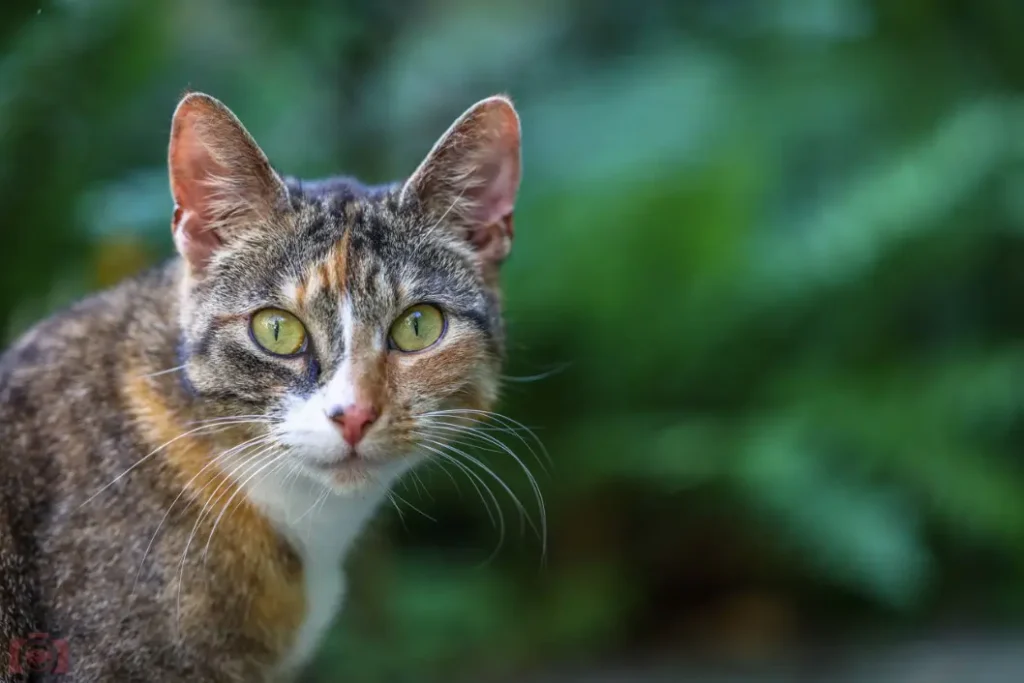
Photo credit: Camera Deals / Yoreh Schipper. Check this photo in a bigger size.
Even when she closes her eyes to clean herself, the eye focus switches to face focus.

Photo credit: Camera Deals / Yoreh Schipper. Check this photo in a bigger size.
I found a fast-moving dragonfly taking a break on a leaf. The focus worked fine, but it recognized it as a whole object. It would have been exceptional if it recognized the eyes as well.

Although the eyes of the dragonfly were not recognized, its small body was detected. In this case, the choice of f/2.8 was not wise, as only a small part of the body is in focus. Canon EOS R5, 700mm f/2.8. Photo credit: Camera Deals / Yoreh Schipper. View this photo in high resolution.
Works less well with fast-moving animals
While the animal and bird recognition works well when the subject is not moving quickly, I found the autofocus a bit disappointing with faster-moving animals coming towards you (e.g., birds). Especially when trying to capture close-ups, the autofocus starts searching. Therefore, it is advisable to turn off eye focus when dealing with faster-moving animals, so that only the body is recognized. This increases the chance of getting sharp photos.
This Nile goose chick posed nicely. No worries, the parents were nearby, and the chick happily continued after the photoshoot.
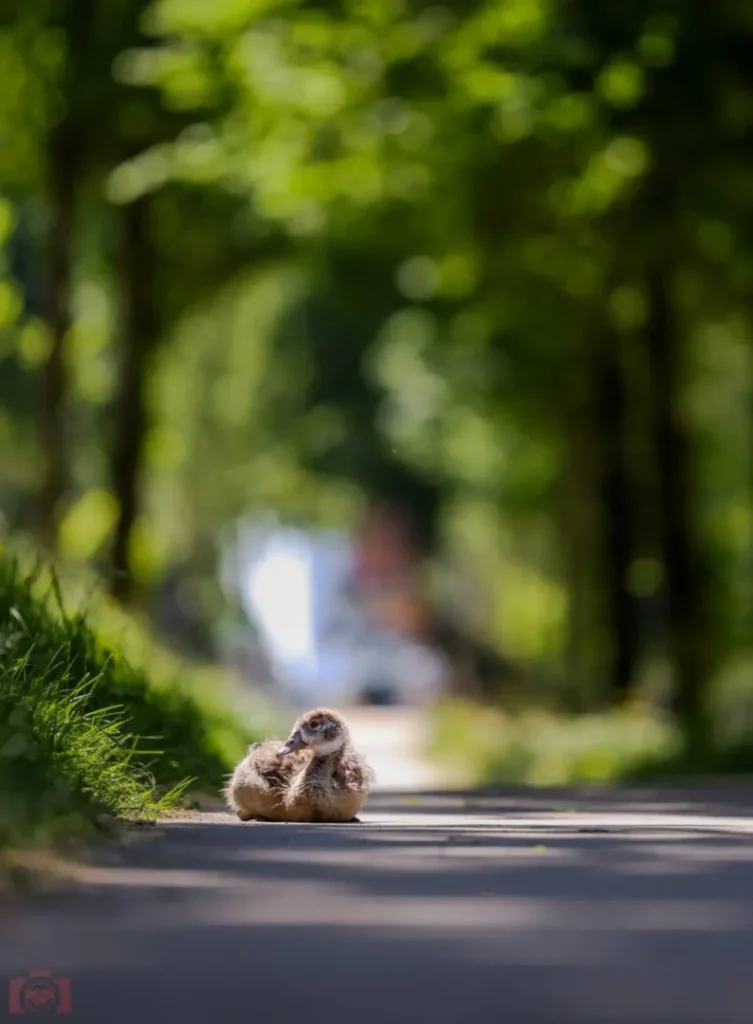
Photo credit: Camera Deals / Yoreh Schipper. View this photo in high resolution.
Humans
The most well-developed Canon autofocus is that of human faces and eyes. The focusing options are extensive, as you can even choose to track only the right or left eye. This is useful when you have a model where a specific side of the face always needs to be sharp. In both well-lit and less well-lit situations, with Canon RF lenses, I noticed that the Dual Pixel AF II system has no trouble finding and tracking people’s eyes.
It’s evident how, even while wearing slippers, I can walk through the hallway, and the autofocus recognizes the back of my head, and when I turn around, my eyes are immediately detected.

It’s a pity that the EOS R5 didn’t recognize the camera, but that may be because it was the competitor’s Nikon Z6 II. 😉
Vehicles
On my way back from the park, I pass a good road for capturing moving cars. In AF vehicle mode, the autofocus immediately recognizes the cars and puts a large box around them. Remarkably, even (cargo) bikes and trams are recognized and tracked effectively.
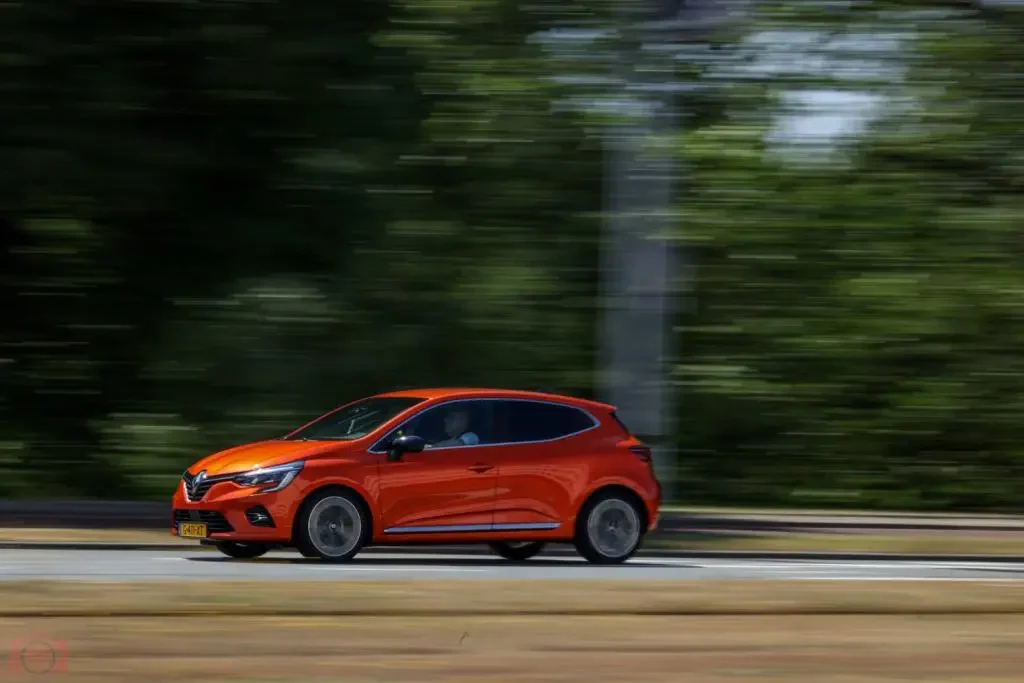
Photo credit: Camera Deals / Yoreh Schipper. Canon EOS R5, f/32, ISO 200, 1/30s, 147mm. View this photo in high resolution.
Below is one of the successful shots with a low shutter speed and active vehicle recognition.
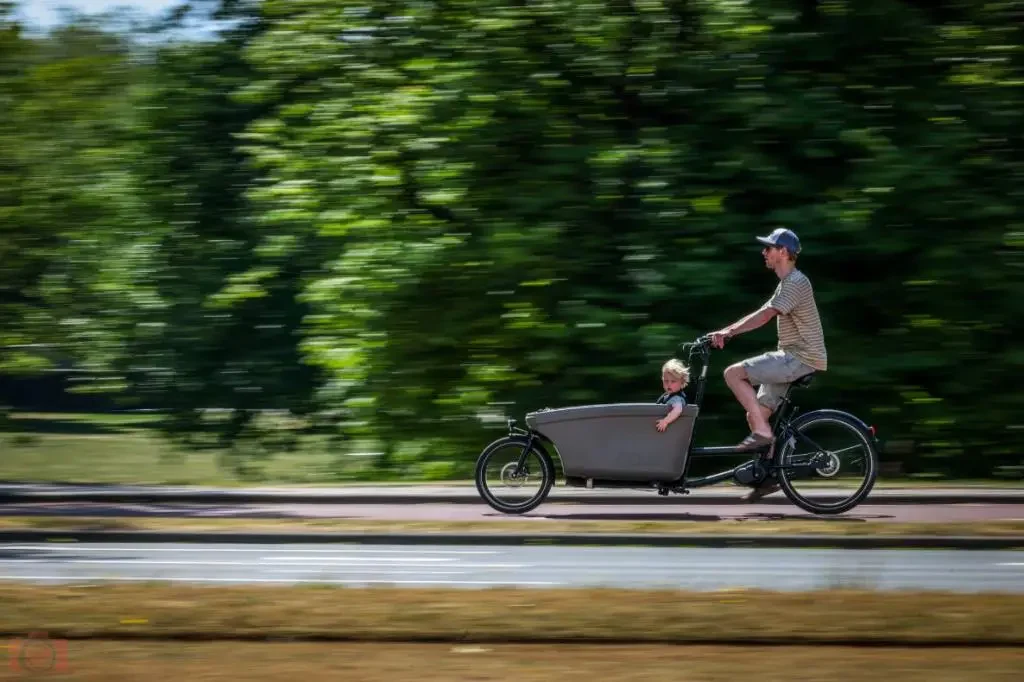
Photo credit: Camera Deals / Yoreh Schipper. Canon EOS R5, f/32, ISO 200, 1/30s, 200mm. View this photo in high resolution.
Even the tram was recognized and tracked as a large block-like vehicle.
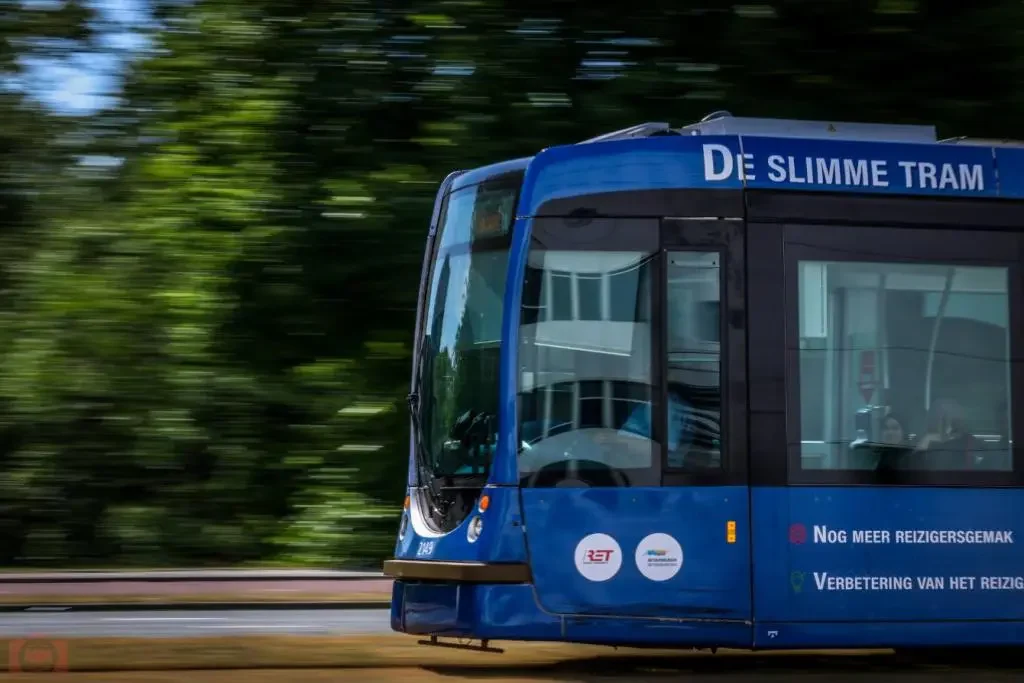
Photo credit: Camera Deals / Yoreh Schipper. Canon EOS R5, f/32, ISO 200, 1/30s, 119mm. View this photo in high resolution.
Canon EOS R5 Test and Review: LCD Screens
On the back, we find the 3.2-inch LCD screens. This screen can be rotated in all directions, making it suitable for capturing selfie vlogs. Scrolling through the menu is smooth, and focusing on subjects by touch works well too. It is also possible to take a photo directly by tapping on a point on the screen.
On the left side of the body, the USB-C and Micro HDMI outputs are located, and when you connect a cable, it blocks the free movement of the LCD screen. I experienced this, especially when navigating the camera menu.
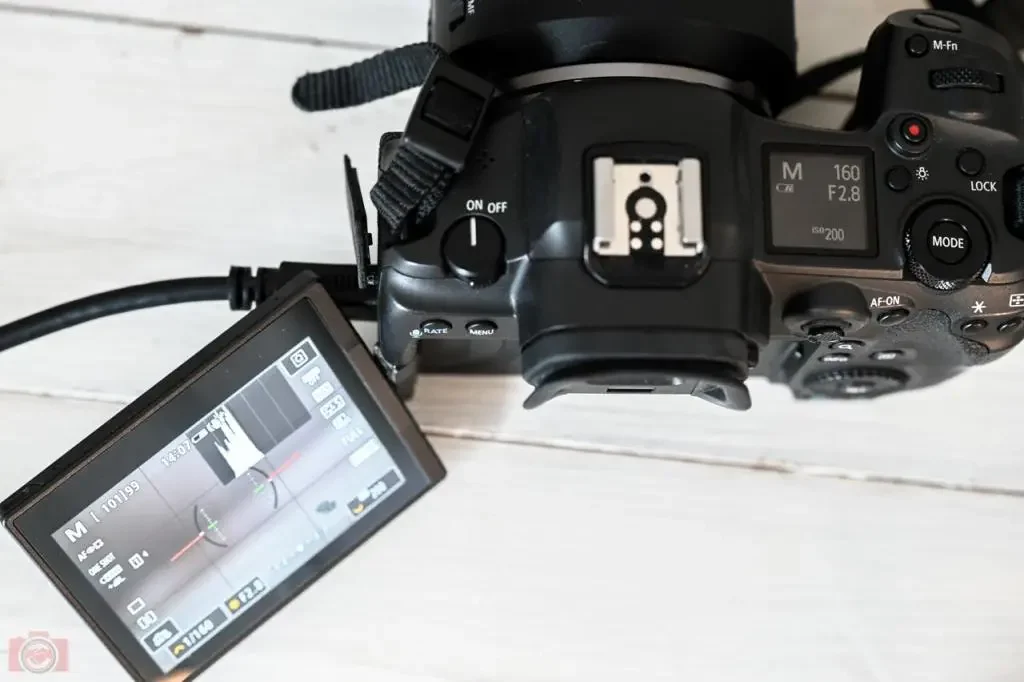
An image showing how the micro HDMI cable obstructs the full rotation of the LCD screen.
You can adjust the screen’s brightness via the menu, and even in bright light, I could still read the screen well. It’s only when the sun shines directly onto the screen that readability becomes more challenging.
Top LCD screen
Canon has placed a small black and white LCD screen on top of the body. This screen shows you all the essential setup information. Right next to the screen is a button to illuminate the screen, which is useful when it is dark. If you press the lamp button longer, you can reverse the black and white colors. You actually get a negative; what was black now becomes black and vice versa.
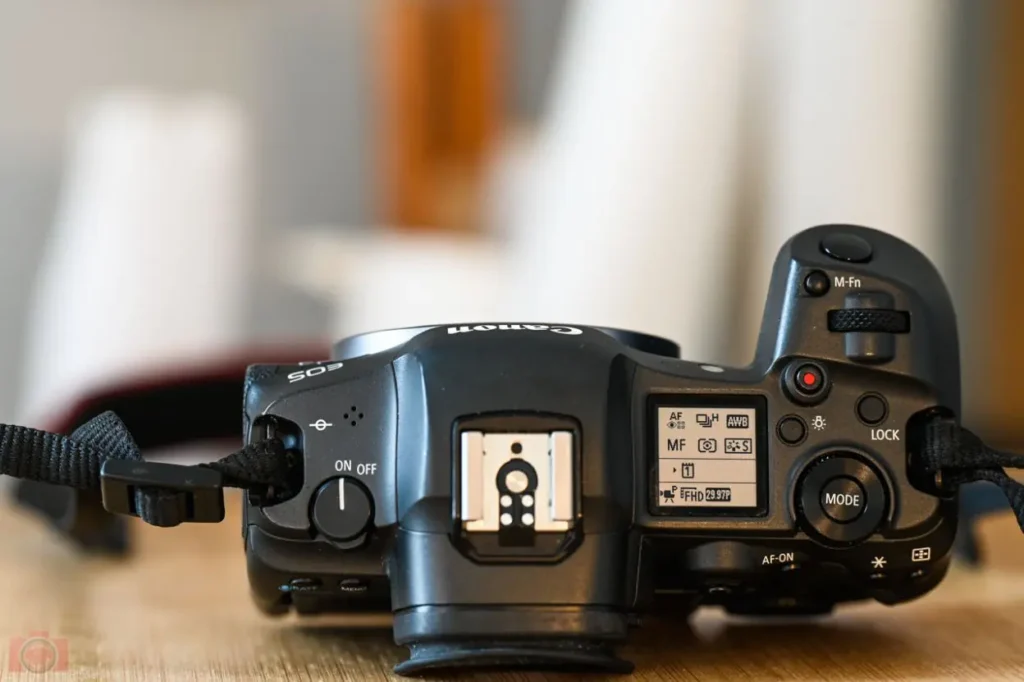
The LCD screen at the top can be illuminated and set to white-black or black-white. Photo: Yoreh Schipper / Camera Deals
Electronic Viewfinder
The OLED viewfinder of 0.5-inch and 5.76m-dot on the EOS R5 is remarkably sharp and has a refresh rate of 60 to 120 frames per second. If you want to take photos of fast-moving subjects, it is recommended to use the first curtain shutter or electronic shutter. This prevents blackout in your images and makes it easier to keep a subject you’re following well framed. It’s possible to manually set the viewfinder to 60fps to extend battery life.
Canon EOS R5 Test and Review: Menu
Canon is known for its easy-to-navigate menus, but you can tell they are still geared towards navigating menus with buttons rather than touch. It’s nice that each menu fits the screen, and you don’t have to scroll. When a menu can scroll, I often forget which page had what setting. With the AF menu, for example, the settings for Servo AF can be found under the tab.
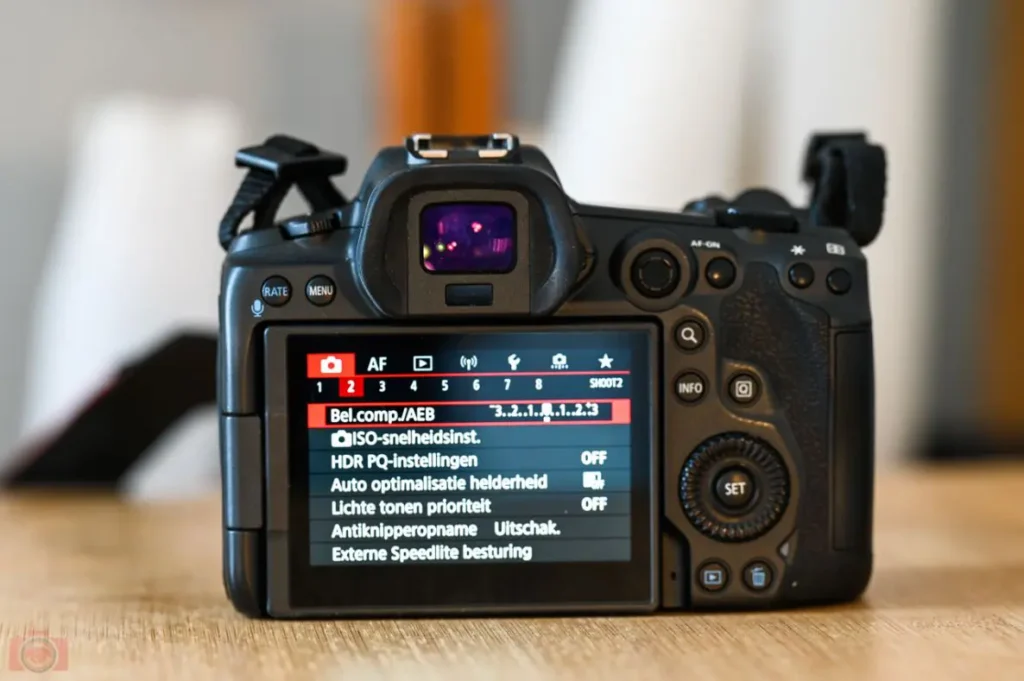
EOS R5 with the menu in Dutch. Photo: Yoreh Schipper / Camera Deals
The menus and settings for photography and video are completely separated. This has both advantages and disadvantages. It’s a plus when it comes to clarity and finding settings. The EOS R5 offers many customizable details, and of course, that requires space. However, for hybrid photographers and filmmakers, it’s a bit cumbersome to have to switch the camera mode via the Mode+Info button repeatedly (more on this in the ‘buttons’ chapter). In practice, users may choose either photography or video more frequently, rather than frequently switching between the two modes, which would have been handy for this review.
Canon EOS R5 Test and Review: Buttons
Canon is economical with the number of buttons. On the left side of the camera, you have the power switch, and just below it (at the back) is the ‘rate’ rating button and the ‘menu’ button. Rating photos with stars works directly without extra settings, and the rating is also transferred to the computer, so you’ll see it in your Apple or Windows finder. It’s also possible to record voice memos to add information about the photo, exposure, or conditions.
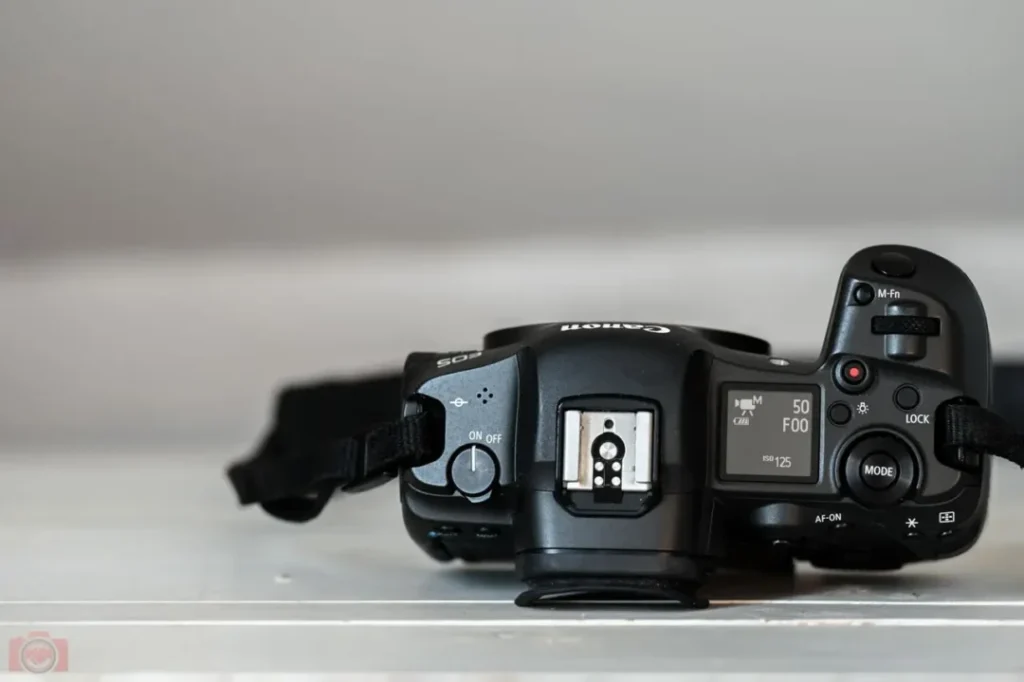
Buttons on top of the Canon EOS R5. Photo: Yoreh Schipper / Camera Deals
Adjusting Shutter Speed, ISO, and Aperture
For adjusting the shutter speed, ISO, and aperture, you use three different dials. To adjust the aperture, you use the dial that you normally use to scroll through the menu or photos. Adjusting the ISO is done using the dial surrounding the ‘mode’ button. The shutter speed is adjusted using the dial behind the shutter button. It’s a pity that these three buttons are quite far apart. This means that you sometimes have to take your eye off the camera to find the right dial. This can take a moment and disrupt the workflow. Of course, with lenses like the RF 24-70mm f/2.8L IS USM and RF 70-200mm f/2.8L IS USM, you can use the additional ring to which you can assign functions. To use the ring function, you have to press the ‘af-on’ button.

The small black-and-white top screen provides all the information about the settings. This is especially useful when using the EVF. It’s possible to change the background from light with black letters to dark with white letters.
Switching between Photography and Video Mode
I expected a physical button for switching between video and photo mode, but the process is a bit more cumbersome. When you click ‘mode’ in photo mode, you get the option to choose between A+, FV, P, TV, AV, M, Bulb, C1p, C2p, C3P modes. To switch to video mode, you click the ‘mode’ button and then the ‘info’ button. Now you’re in video mode, and the menu is adjusted accordingly. Although hybrid content creators will likely choose either film or photography during shooting, it’s challenging to have both modes ready quickly. While the absence of this physical button saves space, I would have preferred to have it.
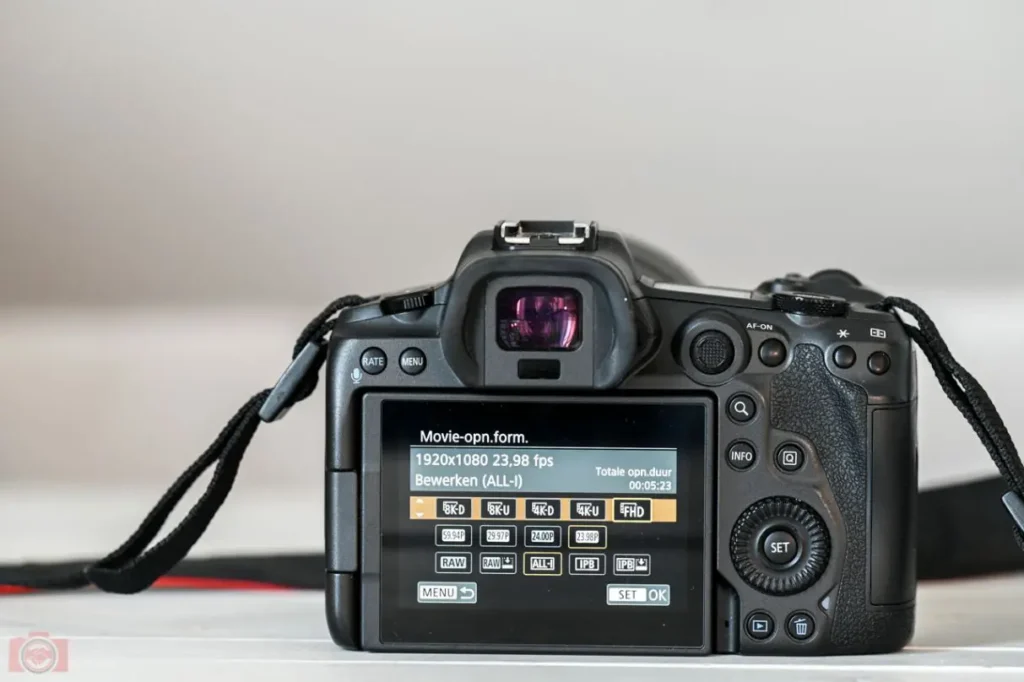
To switch between photography and video, you have to press the ‘mode’ button (on top) + ‘info’ button (at the back).
It’s a shame there’s no physical switch for this. It takes extra time, and you might miss important moments when you’re both shooting photos and videos. From the photo mode, it’s possible to record videos using the dedicated ‘rec’ button, but it always records in Full HD. When you change this to, for example, 4K, the mode automatically resets to Full HD when you switch back to photography mode. There may be a solution for this, but I couldn’t find it. If you know it, please let me know in the comments!
Canon EOS R5 Test and Review: Video
The Canon EOS R5 is marketed as a hybrid camera, which means it is suitable for both high-quality filmmaking and videography. While recording in 8K 30fps is the most remarkable feature in terms of video resolution, the 4K HQ option may be even more important.
Recording in 4K HQ
When you set the video to the 4K HQ recording mode, the image is oversampled from 8K and downsized to 4K. This means that all the possible pixels and resolution are utilized and then compressed into a smaller resolution. You can imagine the extra pixels and sharpness this brings to 4K videos.
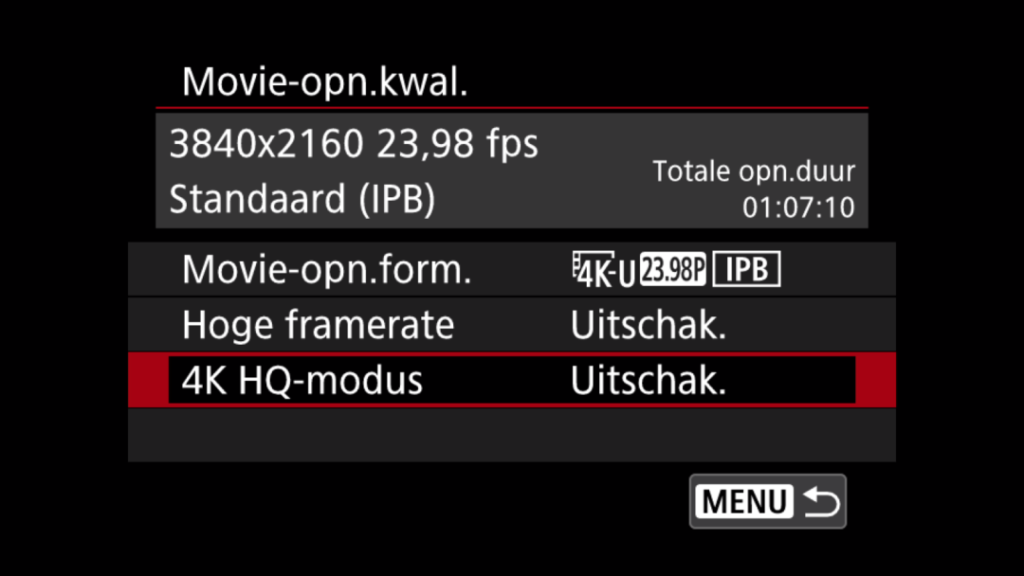
By enabling the 4K HQ mode, 8K footage is downsized to a 4K output. Menu in Dutch: 4K HQ-Mode.
Another advantage of using 8K material is that you get full 4K readouts of the Red, Green, and Blue channels. This results in less noise and a higher-quality end product.
One convenient aspect of the Canon video menu is that you can quickly switch to the 4K HQ and Slow motion modes from any resolution. If the camera is set to 8K, for example, the options to switch to 120fps and 4K HQ are always available. Therefore, you don’t need to first set the camera to 4K.
Slow Motion
Creating slow-motion footage with the EOS R5 means real slow motion without compromises. You can record 4K 120fps footage in 4:2:2 10-bit, which means you have all the depth of colors without moiré. The latter is often present in slow-motion footage due to lower bitrates.

Example of 120fps 4K 4:2:2 10-bit on the Canon EOS R5. Better examples can be found in the YouTube version of this review. Image credit: Camera Deals / Yoreh Schipper
Filming in 8K
With the Canon EOS R5, you can choose to record material in 8K resolution. Currently, this resolution is mainly suitable if you have an 8K display or if you use significant reframing. The heaviest 8K version is the 12-bit RAW internal recording. During my time with the R5, I was provided with a 64GB SanDisk card with a write speed of 800MB/s. This is not fast enough for recording 8K RAW 12-bit. It is possible, but the recording stops after 5 seconds. Fortunately, I didn’t encounter any issues with 8K RAW (small), 8K All-I, and 8K IPB.
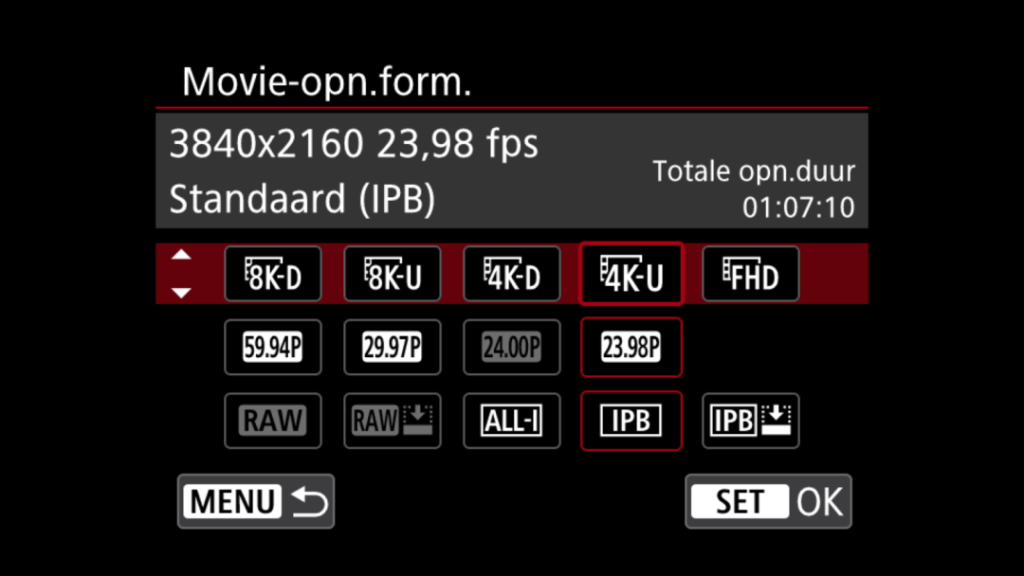
Below is a video grab of a 4K-D HQ All-I C-Log image that I compared with an 8K-D RAW (small) 24fps video frame. To make the images match, the 8K frame is scaled to 50% size. At first glance, you may not see much difference in quality between the two images.
But when we zoom in on the images, the quality differences become more visible.
In the image below, you can see that the text on the books and the photo on the blue book are much sharper and clearer in the lower 8K frame.
Recording 8K material is useful if you want to zoom in on your footage, add extra stabilization, or simply capture the sharpest image possible.
C-Log and C-Log3
Canon offers the option to record in C-Log and C-Log3 color profiles. These flat color profiles provide a larger dynamic range, allowing you to extract more information from highlights and shadows. Most filmmakers seeking a cinematic look will prefer to use Log profiles. The major downside is that color grading is more challenging and time-consuming. Therefore, use this option only if you know how to quickly color grade or if you are shooting scripted scenes that require cinematic enhancement.
Overheating
When the Canon EOS R5 was announced, 8K and 4K resolution were the highlights. After filmmakers got their hands on the camera, complaints about overheating quickly emerged. The EOS R5 overheats quickly in both 8K and high 4K formats. Now, there are fans available, such as the Tilta, that aid in cooling. However, this requires attaching the fan to the back of the EOS R5, while the LCD screen is flipped open. This removes the idea of a compact mirrorless camera and makes the entire filming process somewhat cumbersome. In the meantime, Canon has also released the Canon EOS R5C, which comes with a built-in fan. The EOS R5C takes it a step further and can film in 8K 60fps.
While testing the video features on the EOS R5, I also noticed that the camera overheats quickly. I spent an hour or two in a small park where I switched between photography and video. When recording in 4K HQ, slow motion, or 8K, it only took a few minutes for the overheating icon to appear. During my test, the camera did not shut down on its own because I allowed it to cool down in time. However, it’s notable, and I have not seen this happen with other cameras before.
Canon EOS R5 Test and Review: Conclusion
The Canon EOS R5 is a professional camera that caters to hybrid photographers and filmmakers. The camera provides users with professional connections for creating high-quality films and photos. For many, the extensive features and connections may be more than they need, making the camera less appealing at a price of €4500. On the other hand, all these features can enhance creativity and may even spark new interests or knowledge in film and photography. With its internal and external capabilities, the camera is future-proof. We have already seen that the EOS R5 is good enough for a 400-megapixel update, which was released three years after its launch.

Sunrise above the Rotterdam skyline. Shot on Canon EOS R5, f/2.8, 1/3200, ISO 100, 62mm with RF 70-200mm f/2.8L IS USM. In this edited photo, you can see how the image holds up when highlights are set to -100% and shadows to +100%. Photo credit: Camera Deals / Yoreh Schipper. View this photo big size.
The ability to shoot in 8K RAW 12-bit internally is undoubtedly a technological achievement, but not many filmmakers will use it regularly. If you’re working on a project that requires 8K RAW footage, you probably already have access to an external monitor. Even if you’re not shooting in RAW but still in 8K, the files take up a lot of space on memory cards and demand considerable power from your computer. And then there’s the overheating issue, which hasn’t really been resolved three years after the camera’s release.
This camera is intended for professional photographers and filmmakers who already have all the accessories, such as memory cards, lenses, and video cages, ready or are willing to invest at least €10,000 in the purchase. The question then arises, is it worth the money? Yes, absolutely. The Canon EOS R5 competes, among others, with the Nikon Z9 and Sony A7R V, both of which we hope to review soon. Currently, the EOS R5 is the cheapest of the three.
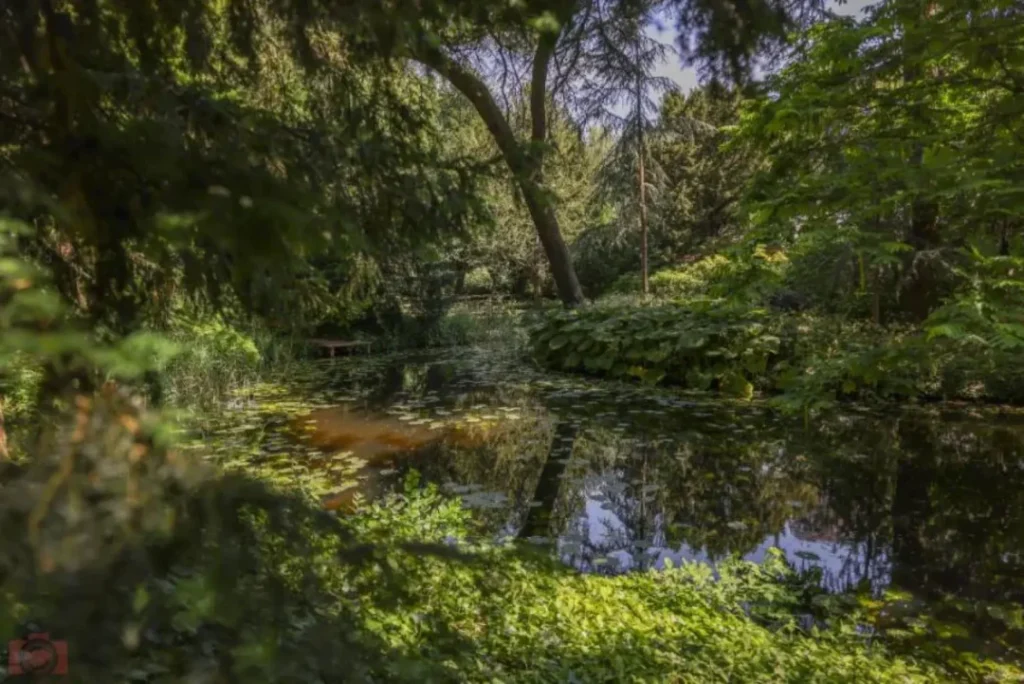
Photo credit: Camera Deals / Yoreh Schipper. View this photo in large format.
Canon EOS R5 Test and Review: Frequently Asked Questions (Q&A)
Where can I buy the Canon EOS R5?
The Canon EOS R5 is available at major camera stores such as BHPhotovideo and Adorama. Below are the stores where the EOS R5 is available.
How long does the Canon EOS R5 last?
According to Canon, the Canon EOS R5 can handle 500,000 clicks in use. The EOS R5 is a pricey but robust camera, making it able to withstand rough handling and fully weather-sealed. Due to its advanced technology and future firmware updates, the camera is future-proof. With proper maintenance and storage, it is entirely possible to use the camera for 10 years.
Who is the Canon EOS R5 for?
The Canon EOS R5 is primarily intended for hybrid creators who want the flexibility to switch between high-quality photography and filmmaking. The EOS R5 is popular among (semi) professional wedding, bird, reportage, portrait, architecture, and landscape photographers, as well as filmmakers.
What is Camera Deals Online?

We at Camera Deals Online find the best video and photo camera, lens and drone and online prices for you. With us, you can find camera prices, top-lists and we write reviews and blogs with tips and camera information. In addition, we give you the latest news about cameras, smartphones, camera equipment, film, and the photography field. This way, we help you find and buy the best camera, lens, drone, gimbal and accessories. Our website is 100% independent.
Camera Deals Online exists thanks to you! When you buy a product through one of our links, we receive a small percentage of the total amount. This has no effect on the price of the product. Thank you!
News and recent posts

 Amazon.com
Amazon.com
